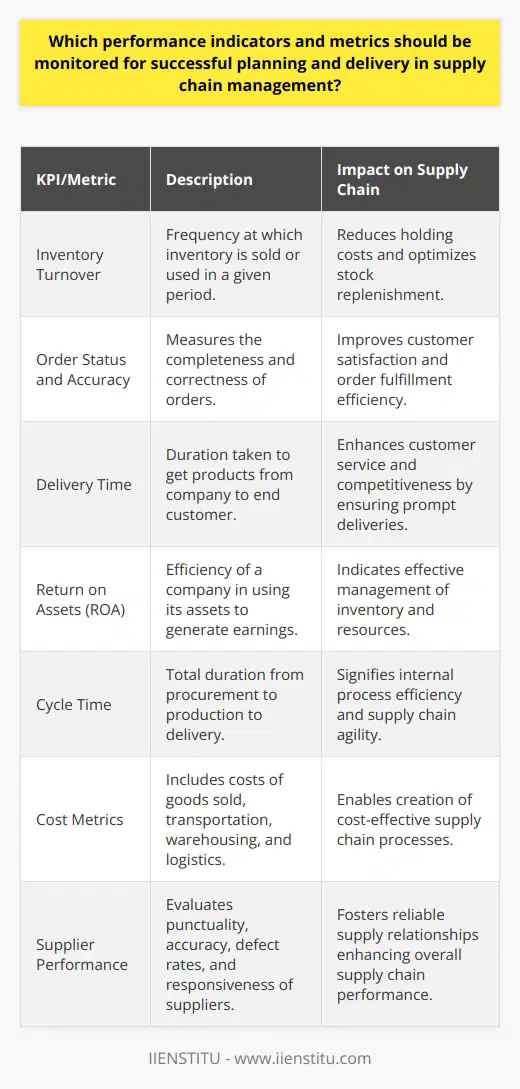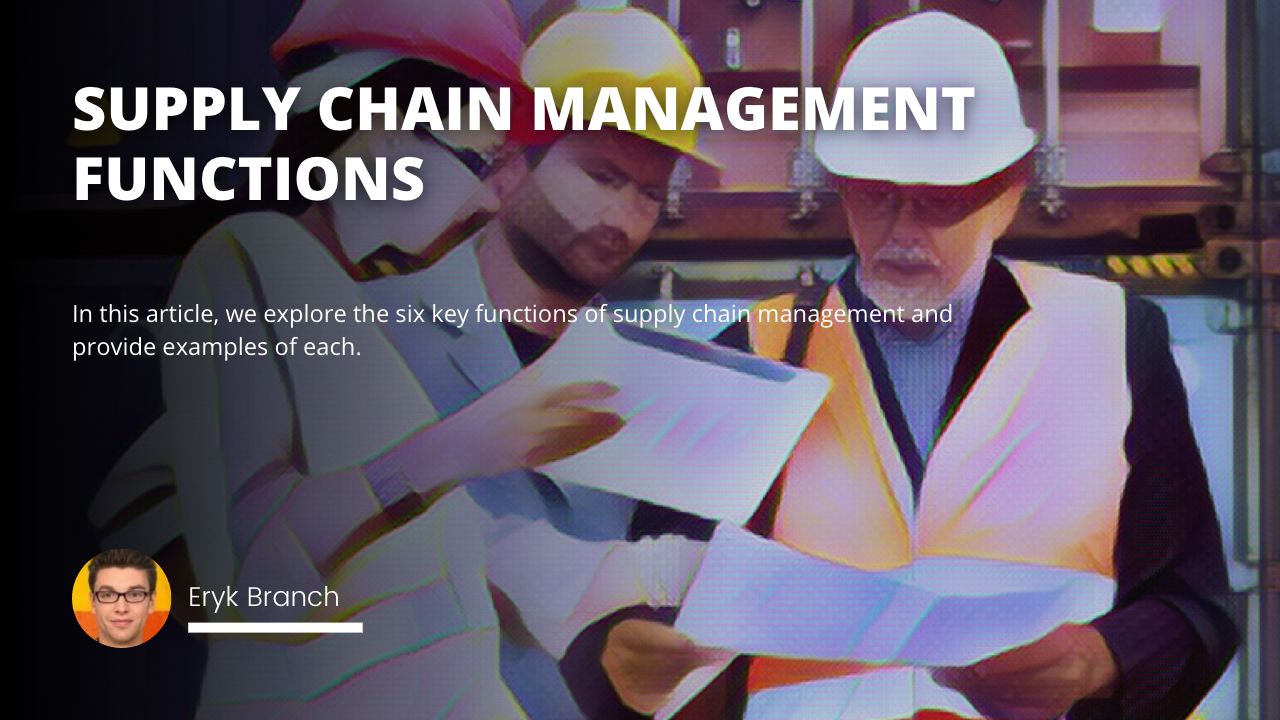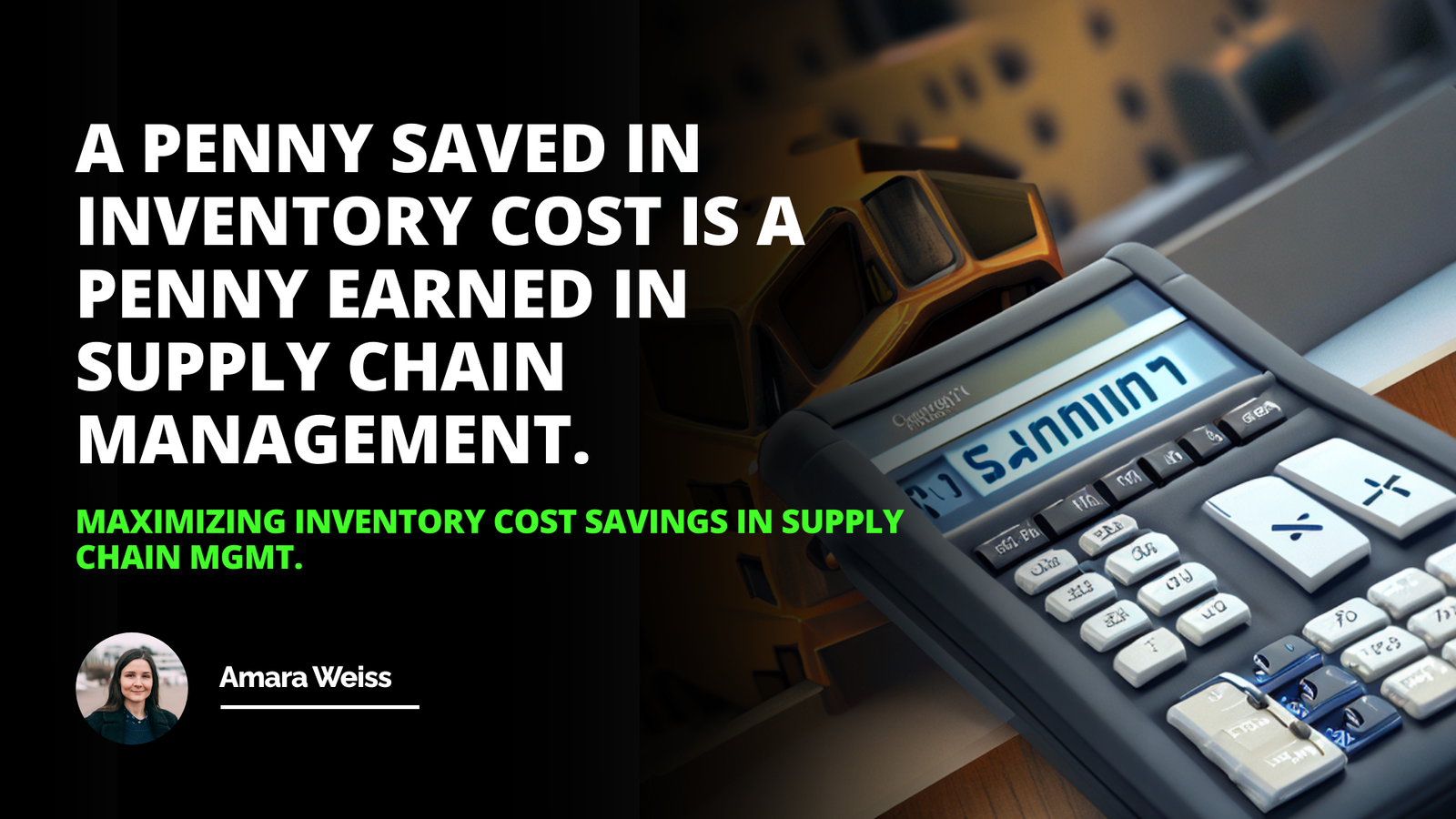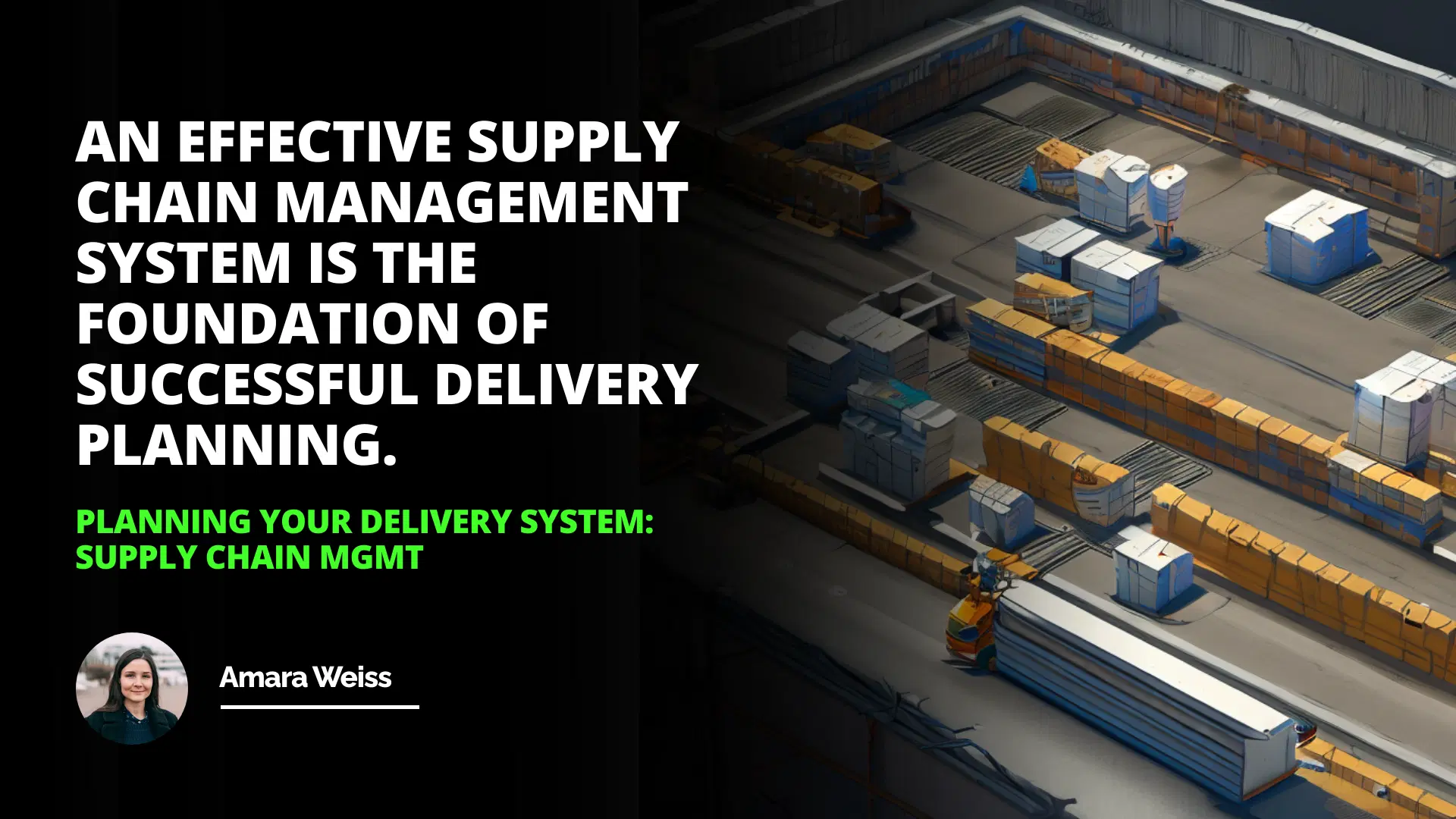
I still remember the first time I stepped into my grandfather's small warehouse. The scent of freshly packed goods mingled with the faint aroma of cardboard boxes filled the air. Grandpa Joe ran a modest supply business, and as a curious kid, I was fascinated by the hustle and bustle of his daily operations. Little did I know that I was witnessing the complexities of logistics and supply chain management firsthand.
The Heartbeat of Business: Understanding Logistics
Logistics is more than just moving goods from one place to another; it's the lifeblood that keeps businesses thriving. Imagine trying to deliver fresh produce without a proper plan—by the time it reaches the customer, it's no longer fresh. Supply chain mgmt ensures that products are delivered efficiently, meeting the needs of both the business and the customer.
Introduction to Logistics
Planning Your Logistics Network
Transporting Your Products
Storage and Fulfillment
International Trade Considerations
My Journey into Logistics
Years later, inspired by Grandpa Joe's passion, I ventured into the world of logistics myself. I quickly realized that optimizing the supply chain management process isn't just about moving products; it's about meticulous planning and understanding every component involved.
Planning Your Logistics Network: The Blueprint to Success
When I started my first business, a small online store selling handmade crafts, I overlooked the importance of a well-planned logistics network. Orders were delayed, inventory was mismanaged, and customer satisfaction plummeted. It was a harsh lesson, but it taught me the value of careful planning.
Key Elements to Consider
To effectively plan a logistics network, consider the following:
1- Locations Involved: Know where your suppliers, warehouses, and customers are located.
2- Product Characteristics: Understand the size, weight, fragility, and perishability of your products.
3- Customer Needs: Timeliness, packaging preferences, and special delivery instructions.
By focusing on these elements, I transformed my business operations. I established a transport management system that streamlined deliveries and improved customer satisfaction.
Uniting Engineering And Procurement For Efficient Supply Chain Management
İn-transit Visibility Solutions For İmproved Supply Chain Efficiency
Transporting Your Products: Choosing the Right Mode
One size doesn't fit all when it comes to transportation. I learned this the hard way when sending delicate glass ornaments via standard shipping. Several arrived broken, leading to unhappy customers.
Modes of Transportation
Air Freight: Fast and efficient for long distances, ideal for perishable or urgent goods.
Sea Freight: Cost-effective for bulky items but slower.
Road Transport: Flexible and accessible, suitable for regional deliveries.
Rail Transport: Economical for large volumes over land.
Choosing the right mode depends on:
Product Type: Fragile, heavy, or perishable items require special handling.
Cost Constraints: Balancing budget with customer expectations.
Time Sensitivity: Urgent deliveries may necessitate faster methods.
By implementing an advanced planning system, I was able to select the best transportation modes for different products, reducing costs and improving delivery times.
Storage and Fulfillment: Keeping the Wheels Turning
Effective storage is more than stacking boxes in a warehouse. It's about creating a system that ensures products are easily accessible and orders are fulfilled promptly.
Strategies for Efficient Storage
Inventory Management Software: Helps track stock levels and prevent overstocking or stockouts.
Warehouse Layout Optimization: Organize products logically to speed up picking and packing processes.
Quality Control Measures: Regular checks to ensure products remain in good condition.
An adequate supply chain management system is the foundation of successful delivery planning.
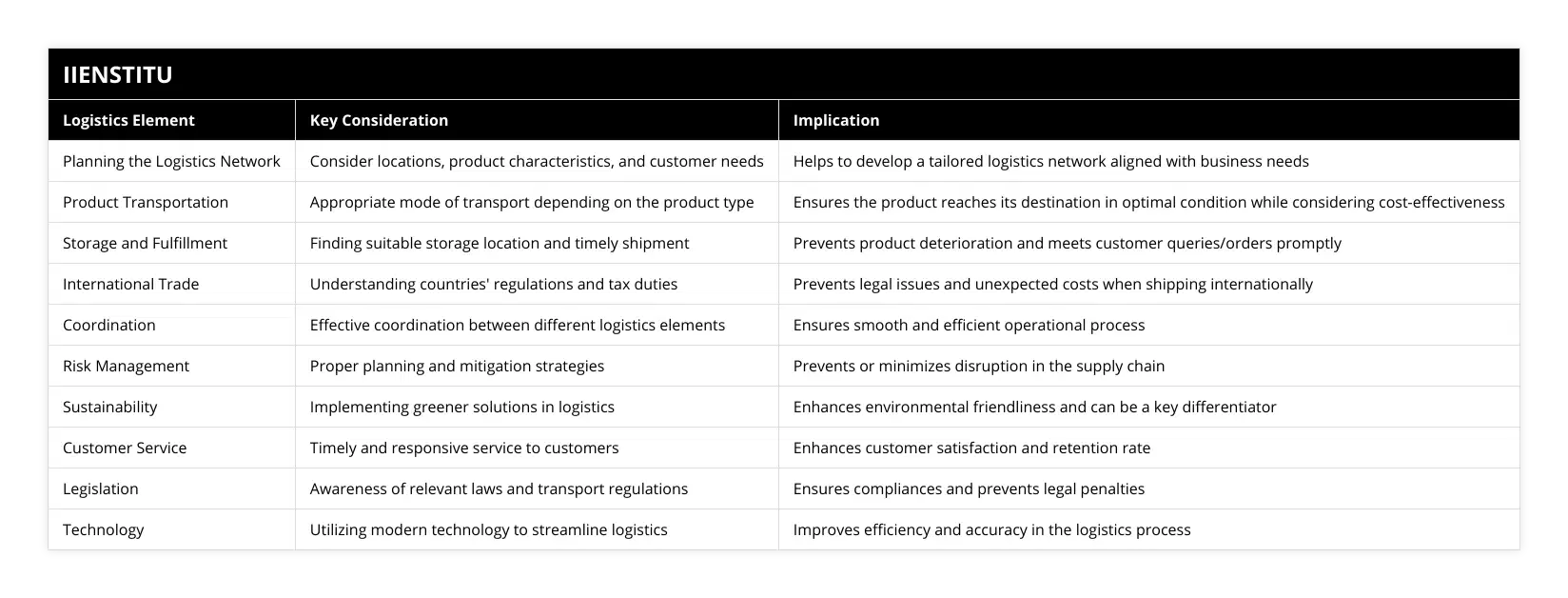
Embracing these strategies transformed my fulfillment process. Orders were processed faster, and customer feedback improved significantly.
International Trade Considerations: Navigating the Global Market
Expanding my business internationally was both exciting and daunting. Different countries have varying regulations, taxes, and customs procedures.
Lessons Learned
Understand Import/Export Regulations: Each country has specific rules about what can be imported or exported.
Taxes and Duties: Be prepared for additional costs, and inform customers to avoid surprises.
Cultural Sensitivities: Packaging and marketing materials may need adjustment for different markets.
By partnering with experts in supply and chain management, I navigated these challenges effectively, opening my business to a global audience.
The Role of Supply Chain Departments in Business Growth
In larger organizations, supply chain departments play a crucial role in managing logistics. They oversee everything from procurement to delivery, ensuring that each link in the chain functions smoothly.
Functions of Supply Chain Departments
Procurement: Sourcing materials and negotiating with suppliers.
Production Planning: Aligning manufacturing schedules with demand forecasts.
Logistics Management: Coordinating transportation and storage.
Performance Monitoring: Using KPIs to assess efficiency and identify areas for improvement.
Integrating these functions under scm supply chain management provides a cohesive approach, driving efficiency and profitability.
Tips to Optimize Supply Chain Management Process
Over the years, I've gathered some valuable tips to optimize the supply chain management process:
1- Leverage Technology: Utilize software solutions for inventory management and forecasting.
2- Build Strong Relationships: Collaborate closely with suppliers and logistics partners.
3- Continuous Improvement: Regularly assess processes and implement improvements.
4- Risk Management: Identify potential disruptions and develop contingency plans.
5- Sustainability Practices: Incorporate eco-friendly methods to meet regulatory requirements and customer expectations.
Implementing these tips can significantly enhance the efficiency of your management chain supply.
Conclusion: The Art and Science of Logistics
Looking back, my journey through the world of logistics has been both challenging and rewarding. From my early days in Grandpa Joe's warehouse to managing a global supply chain, I've learned that logistics is both an art and a science.
Understanding the nuances of scm management not only helps in delivering products efficiently but also in building a reputable brand. It requires attention to detail, strategic planning, and a willingness to adapt to new challenges.
In the end, effective supply chain management management is about connecting all the dots—from suppliers to customers—in the most efficient and responsive way possible.
References
1- Christopher, M. (2016). Logistics & Supply Chain Management. Pearson Education Limited.
2- Chopra, S., & Meindl, P. (2019). Supply Chain Management: Strategy, Planning, and Operation. Pearson.
3- Rushton, A., Croucher, P., & Baker, P. (2017). The Handbook of Logistics and Distribution Management. Kogan Page Publishers.
4- Ballou, R. H. (2007). Business Logistics/Supply Chain Management. Pearson Education.
5- Bowersox, D. J., Closs, D. J., & Cooper, M. B. (2013). Supply Chain Logistics Management. McGraw-Hill.
Frequently Asked Questions
What are the key components of a successful supply chain management system?
Supply chain management (SCM) is an essential element of a successful business model, allowing for the efficient and cost-effective delivery of goods and services to meet customer demands. The critical components of a successful SCM system include the following:
1) Demand forecasting: Accurately predicting customer demand is essential for the proper supply chain management. Companies must ensure they have the right resources in the right place at the right time to meet customer demands. This requires advanced data analytics, such as predictive analytics and machine learning, to accurately forecast future demand and adjust supply accordingly.
2) Inventory management: Supply chain management systems must also be able to track and manage inventory levels accurately. This includes tracking the movement of goods from suppliers to production and then to customers. Advanced inventory management systems use sophisticated algorithms to track and manage inventory levels in real-time.
3) Supplier selection and management: An effective SCM system must also be able to research, select, and manage suppliers. This includes selecting the most cost-effective and reliable suppliers for sourcing raw materials, components, and services. Companies must also implement processes to ensure suppliers adhere to quality standards, delivery schedules, and other requirements.
4) Transportation management: The transportation of goods and services is integral to any successful SCM system. Companies must ensure they can select and manage carriers, optimize routes, and track shipments in real-time. Advanced transportation management systems use predictive analytics and machine learning to optimize routes and select the most cost-effective carriers.
5) Risk management: Risk management is essential for an effective SCM system. Companies must identify, assess, and mitigate risks associated with supply chain operations. This includes risks such as environmental risks, political risks, and financial risks. Companies must also be prepared to respond to unexpected events, such as natural disasters or pandemics, that could disrupt the supply chain.
In conclusion, the critical components of a successful supply chain management system include demand forecasting, inventory management, supplier selection and management, transportation management, and risk management. By implementing these components, companies can ensure their SCM system is efficient, cost-effective, and reliable.
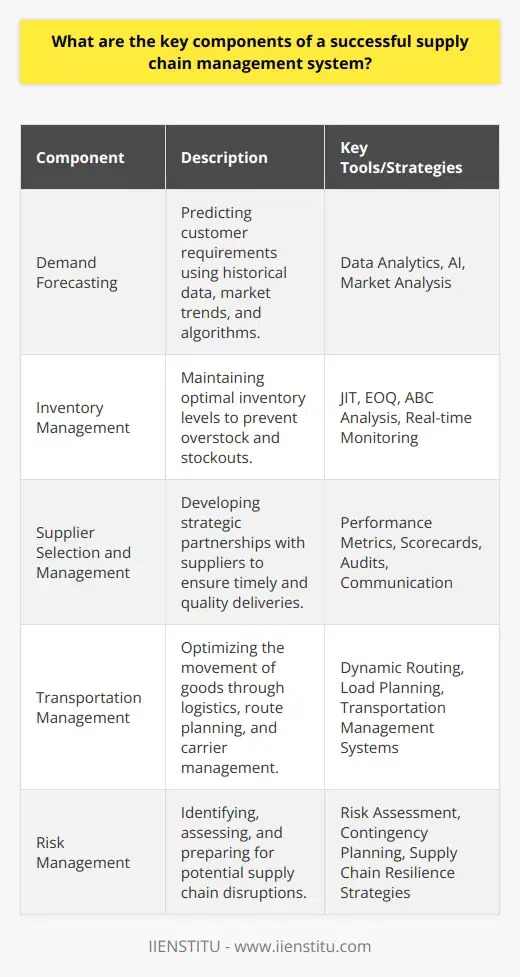
How can I ensure that my delivery system is cost-effective and efficient?
The goal of any delivery system is to ensure that goods are delivered to their destination cost-effectively and efficiently. To achieve this goal, it is essential to consider various factors, such as the size and scope of the delivery system, the type of goods being delivered, and the infrastructure available to support the delivery process. This article will explore a few strategies to ensure a cost-effective and efficient delivery system.
First, it is essential to consider the size and scope of the delivery system. If the delivery system is large or complex, it may be necessary to invest in additional resources, such as larger delivery vehicles, other staff, or specialized software. Additionally, it is essential to consider the types of goods being delivered. For example, fragile or hazardous goods may require additional packaging and/or special handling instructions. Furthermore, the infrastructure available to support the delivery process should be considered. If inadequate infrastructure, such as bad roads or insufficient storage facilities, additional investments may be necessary to ensure a successful delivery system.
Second, it is essential to establish a transparent and efficient delivery process. The process should be well-documented, regularly reviewed, and updated. Additionally, it is necessary to ensure that all staff involved in the delivery process are properly trained and clearly understand the delivery process. Furthermore, it is necessary to monitor the performance of the delivery system to ensure that any issues are addressed promptly and effectively.
Third, it is essential to consider various cost-saving measures. For example, using fuel-efficient vehicles or negotiating reduced shipping rates with suppliers can help reduce the delivery cost. Additionally, it is essential to consider the use of technology to reduce the time and effort associated with delivery. For example, automated tracking systems or barcode scanners can help speed up the delivery process and reduce the need for manual handling.
Finally, it is essential to consider the environmental impact of the delivery process. Using green technologies, such as electric vehicles or renewable energy sources, can help reduce the delivery system's environmental impact. Additionally, it is essential to ensure that the packaging materials used are recyclable and biodegradable.
Taking the time to consider these strategies makes it possible to ensure that a delivery system is cost-effective and efficient. Adopting these strategies can help to reduce costs and improve the efficiency of the delivery process, resulting in a more prosperous and sustainable delivery system.
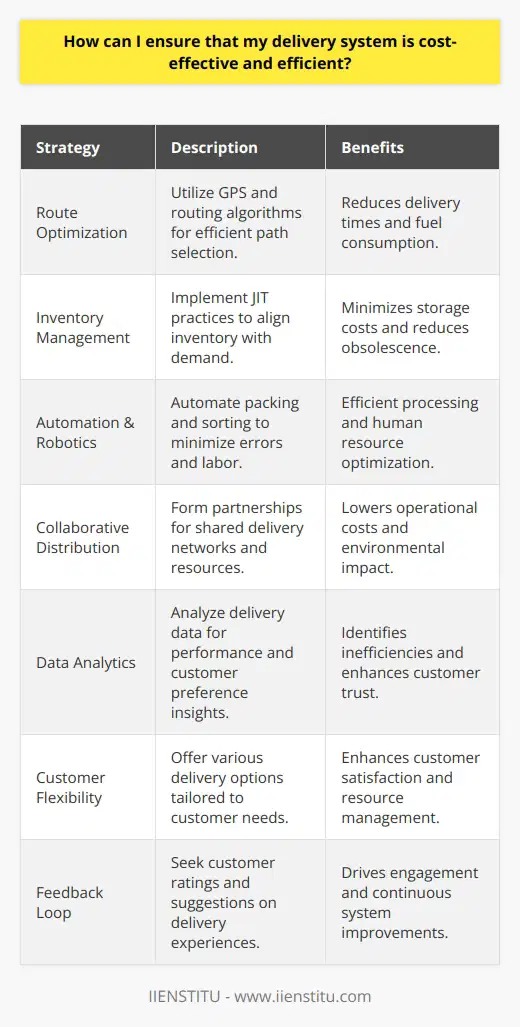
What are the international trade considerations I should take into account when planning my delivery system?
Several considerations should be considered when planning a delivery system for international trade.
Firstly, knowing the various laws and regulations that apply to the countries involved is essential. For example, in the European Union, the General Data Protection Regulation (GDPR) applies and may affect how data related to the delivery is handled.
Secondly, it is essential to consider the logistics of the delivery process. This includes selecting a suitable courier, determining the cost of shipping and customs clearance, and ensuring that the delivery is tracked throughout the process. It is also essential to consider the time it will take for the goods to arrive, as this may affect the customer’s satisfaction with the service.
Thirdly, several cultural considerations should be considered when planning a delivery system for international trade. Different countries may have different expectations when it comes to customer service, delivery times, and packaging. Researching these expectations and tailoring the delivery system to meet them is essential.
Finally, it is essential to consider the environmental impacts of the delivery system. This includes selecting the most appropriate mode of transport, such as air, land, or sea, and minimizing the use of packaging materials. It is also essential to consider using carbon offsetting or other green initiatives to reduce the environmental impact of the delivery system.
In conclusion, when planning a delivery system for international trade, it is essential to consider the various legal, logistical, cultural, and environmental considerations. By taking these into account, it will be possible to ensure that the delivery system meets the needs of both the customer and the environment.
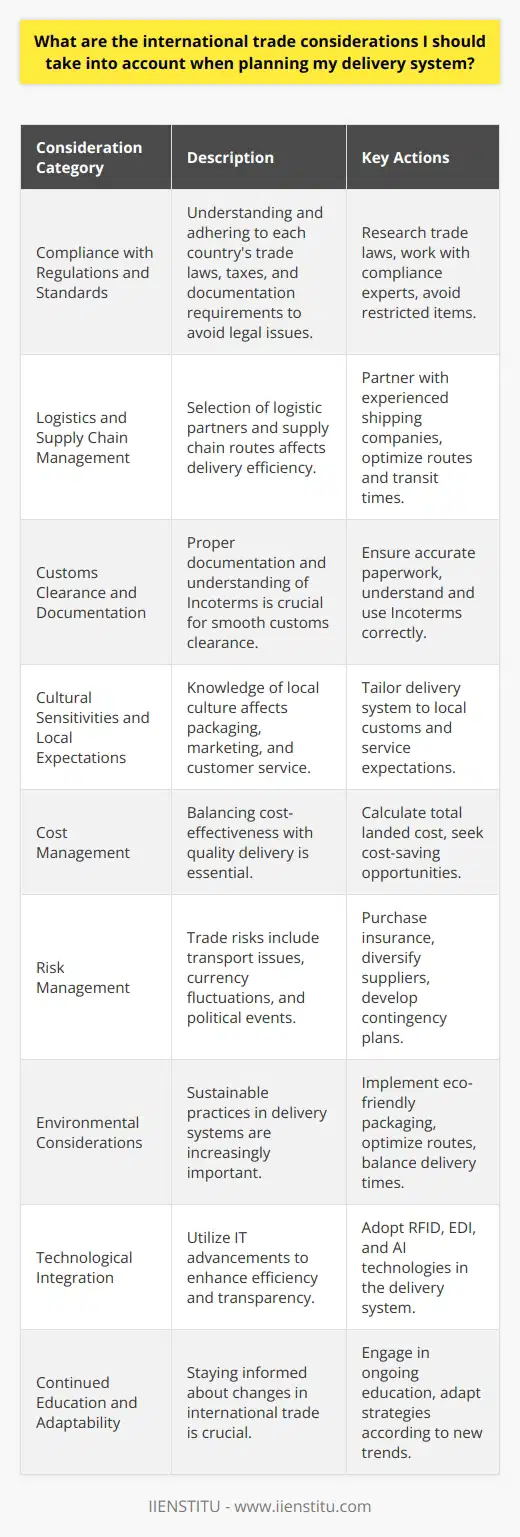
What is planning system in supply chain management?
Tedarik Zinciri Yönetiminde Planlama Sistemi
Planlama Sistemi Tanımı
Tedarik zinciri yönetiminde planlama sistemi, bir işletmenin tedarik süreci ile ilgili faaliyetleri önceden belirleme ve organize etme yöntemidir. Bu sistem sayesinde, işletmeler, tedarik ve üretim süreçlerini daha verimli ve etkili bir şekilde yönetebilirler.
Planlama Sisteminin Önemi
Planlama sistemi, tedarik zincirinin her adımında önemli bir rol oynar. İyi bir planlama sayesinde işletmeler, gerekli kaynakları sağlama, sipariş ve üretim süreçlerini optimize etme, tedarikçilerle olan ilişkileri düzenleme gibi konularda başarılı olabilirler.
Farklı Planlama Türleri
Tedarik zinciri yönetimi kapsamında birkaç farklı planlama türü bulunmaktadır. Bunlar arasında üretim planlaması, envanter planlaması ve lojistik planlaması gibi başlıklar yer alır.
Üretim Planlaması
Üretim planlaması; hangi ürünlerin, ne zaman ve hangi miktarlarda üretileceğini belirleyen stratejik bir süreçtir. Bu planlama işleminin iyi yapılması, üretim hattında verimli bir çalışma sağlar ve tedarik ile üretim süreçlerini düzgün bir şekilde yürütülmesine olanak tanır.
Envanter Planlaması
Envanter planlaması, mevcut ve gelecekteki ihtiyaçların karşılanmasını sağlamak için depolarda bulunan stok düzeylerinin belirlenmesine yardımcı olur. İyi bir envanter planlaması, stok kontrolünü sağlar ve işletmelere maliyetleri düşürme imkânı sunar.
Lojistik Planlaması
Lojistik planlaması, ürünlerin tedarik edilmesi, depolanması ve tüketiciye ulaştırılması süreçlerinin koordinasyonunu içerir. Bu süreç, sipariş ve teslimat sürelerinin optimize edilmesi ve müşteri memnuniyetinin artırılması açısından önemlidir.
Sonuç olarak, tedarik zinciri yönetiminde planlama sistemi, işletmelerin üretim, envanter ve lojistik süreçlerini başarılı bir şekilde yürütmelerine katkı sağlar. İyi bir planlamanın yapıldığı durumlarda hem işletmeler için maliyet tasarrufu, hem de müşteri memnuniyetinin artırılması sağlanır.
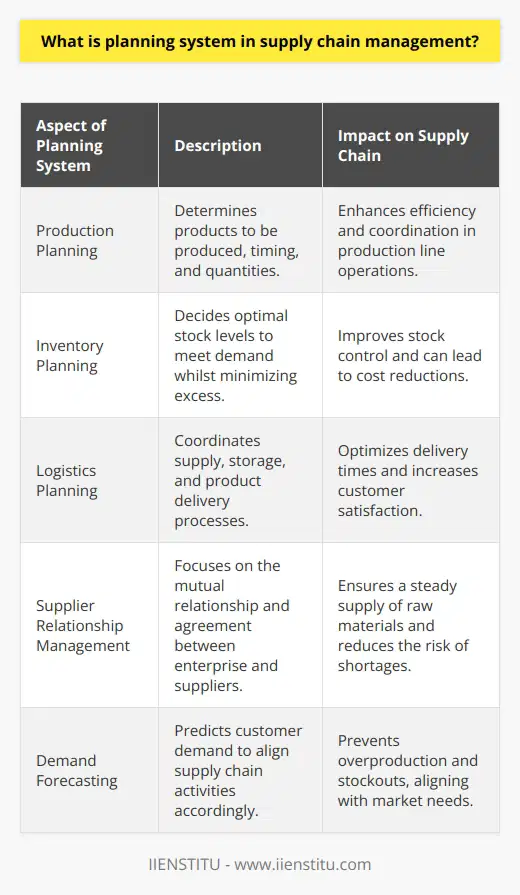
What are the requirements for effective supply chain planning in delivery?
Etkin Tedarik Zinciri Planlaması İçin Gereklilikler
Doğru Veri ve Tahminler
Etkin bir tedarik zinciri planlaması için, güncel ve doğru verilere dayanan, gelecekteki talep ve ihtiyaçları tahminleme yeteneği çok önemlidir. Bu, firmanın müşteri taleplerine daha hızlı ve doğru bir şekilde yanıt verebilmesini sağlar.
Etkili İletişim ve Koordinasyon
İkinci bir gereklilik ise, tüm tedarik zincirindeki paydaşlar arasında etkili iletişim ve koordinasyondur. Bu sayede, şirket içindeki ve dışındaki tüm tedarikçiler, üreticiler ve lojistik hizmet sağlayıcıları kolaylıkla bilgi paylaşımı ve işbirliği yapabilirler.
Çevik ve Esnek Yapı
Üçüncü olarak, tedarik zinciri planlamasında çevik ve esnek bir yapı gereklidir. Özellikle günümüzün hızla değişen pazar koşullarında, şirketlerin yeni taleplere hızlı bir şekilde uyum sağlayabilmesi ve gerektiğinde kaynaklarını yeniden yapılandırabilmesi önemlidir.
Entegre Teknoloji Kullanımı
Dördüncü olarak, etkili tedarik zinciri planlaması için entegre teknoloji uygulamalarına ihtiyaç duyulmaktadır. Modern yazılım ve bulut tabanlı sistemler, şirketlerin tedarik zinciri verilerini ve süreçlerini gerçek zamanlı izleyerek daha verimli ve uyumlu hale getirmelerine olanak tanır.
Risk Yönetimi ve Sürekli İyileştirme
Son olarak, sürekli iyileştirme ve risk yönetimi yaklaşımları da tedarik zinciri planlamasının etkili olmasında önemli bir rol oynar. Şirketlerin karşılaşabilecekleri riskleri önceden belirleyerek, önlem almayı ve sürekli iyileştirme arayışında olmayı sağlamaları, tedarik zinciri performansını ve dayanıklılığını artıracaktır.
Sonuç olarak, etkili bir tedarik zinciri planlaması için doğru verilere ve tahminlere, etkili iletişim ve koordinasyona, çevik ve esnek yapıya, entegre teknoloji kullanımına ve sürekli iyileştirme ve risk yönetimi yaklaşımlarına ihtiyaç duyulmaktadır. Bu unsurların tümü, şirketlerin müşteri ve pazar ihtiyaçlarına daha hızlı ve verimli bir şekilde yanıt vermesine ve böylece rekabet güçlerini artırmasına katkıda bulunacaktır.
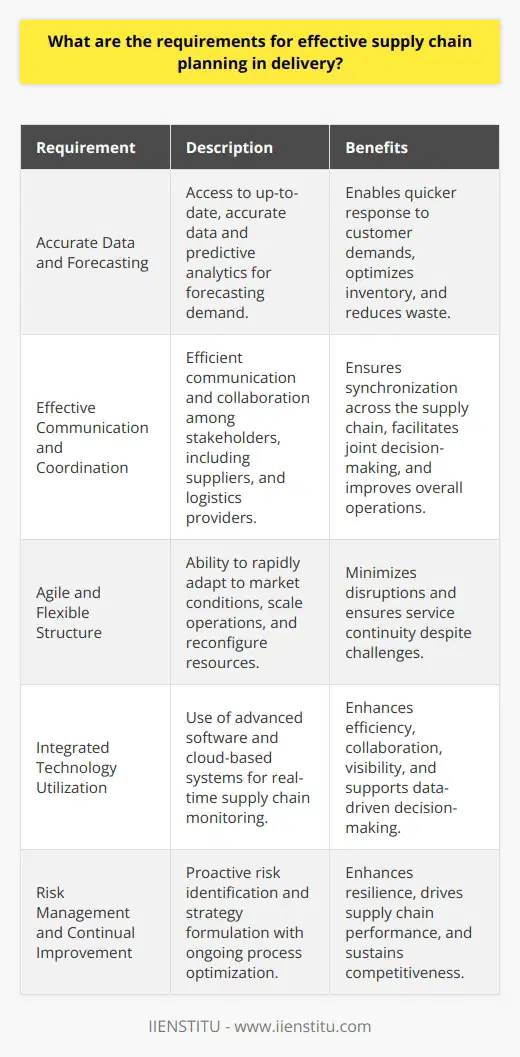
How do you manage supply chain delivery?
Tedarik Zinciri Yönetimi Stratejileri
Etkili tedarik zinciri yönetimi, müşteri memnuniyetini artırmak ve maliyetleri düşürmek amacıyla ürünlerin ve hizmetlerin uygun şekilde planlanması, üretimi ve teslim edilmesini sağlamak için önemli stratejilere dayanır. Tedarik zinciri yönetimi sürecinde kalite, hız ve maliyet unsurları optimum düzeyde dengelemelidir.
İyi bir tedarik zinciri yönetimi, tüm iş süreçlerinde entegrasyon ve koordinasyon sağlayarak verimliliği artırır. İşte başarılı bir tedarik zinciri yönetimi için bazı yöntemler:
Üretim ve Teslimat Sürecinin Planlaması
Üretim ve teslimat süreçleri, tedarik zincirinin önemli bileşenlerindendir. Etkili bir tedarik zinciri yönetimi için üretim sürecini iyi planlamak, optimize etmek ve doğru zamanda teslim etmek esastır.
Depolama ve Envanter Yönetimi
Ürünlerin depolanması ve envanterinin yönetimi, tedarik zincirinin maliyet ve verimliliğini doğrudan etkiler. Etkili envanter yönetimi ile işletmeler doğru ürünleri doğru zamanda depoda bulundurarak, stok maliyetlerini düşürür ve hizmet seviyelerini artırır.
Nakliye ve Lojistik
Doğru nakliye ve lojistik stratejileri ile hızlı ve güvenli ürün teslimatı sağlanır. Bu süreçte seçilen taşımacılık türleri ve rotalarının etkin ve verimli olması, maliyetleri ve teslim sürelerini önemli ölçüde etkiler.
Risk Yönetimi
Tedarik zinciri süreçleriyle ilgili risklerin önceden belirlenmesi ve yönetilmesi başarılı bir tedarik zinciri yönetiminin anahtarlarındandır. Risk yönetimi yaklaşımıyla işletmeler kesintilere karşı daha hazırlıklı olabilir ve tedarik zinciri süreçlerini anlık olarak takip etme becerisi geliştirir.
Tedarikçi İlişkilerinin Yönetimi
Etkili tedarik zinciri yönetimi için güçlü tedarikçi ilişkileri kurmak önemlidir. İşletmeler tedarikçileriyle iyi ilişkiler kurarak, kalite ve teslimat performansını artırır, maliyetleri düşürür ve ortak şekilde riskleri yönetebilir.
Sonuç olarak, tedarik zinciri yönetimi sürecinde etkili stratejiler uygulamak, işletmeler için sürdürülebilir başarı ve rekabet avantajı sağlar. Başarılı bir tedarik zinciri yönetiminin ana unsurları, planlama, entegrasyon, koordinasyon ve doğru stratejilerin uygulanmasıdır.
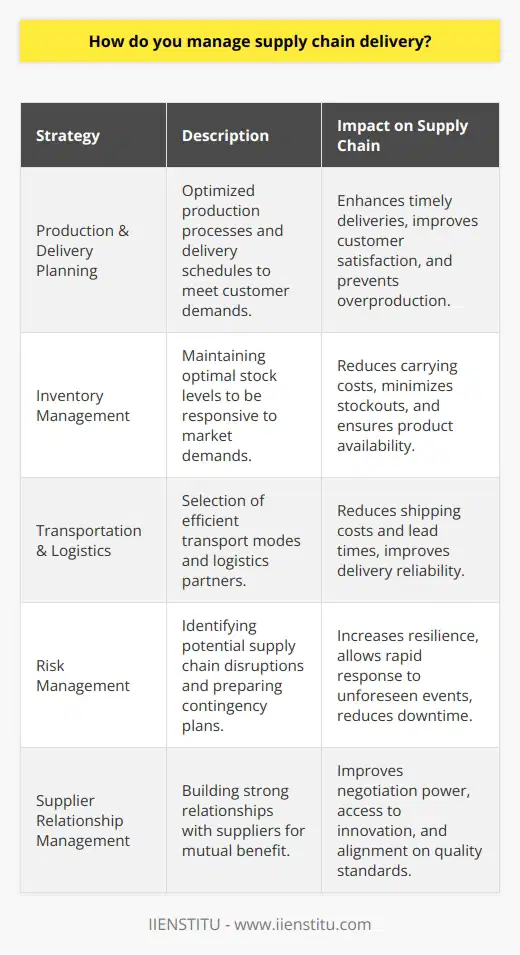
What are the three main components of delivery within supply chain management?
Three Main Components of Supply Chain Management
Component 1: Procurement
The first component of supply chain management is procurement, which involves the acquisition of raw materials, products, and services from suppliers. In this phase, organizations must select the best vendors and establish purchasing agreements, considering factors such as cost, quality, and delivery speed.
Component 2: Production
Production, the second principal component of supply chain management, tackles the conversion of raw materials into finished products. This operation comprises multiple stages, including assembly, manufacturing, and quality control. Efficient production processes require effective planning, monitoring, and resource utilization to optimize output and minimize waste.
Component 3: Distribution
Lastly, distribution focuses on the transport and storage of goods from production facilities to end consumers. This aspect encompasses inventory management, transportation planning, and warehousing operations. Effective distribution ensures the timely delivery of goods, while also minimizing costs and maintaining product quality throughout the supply chain.
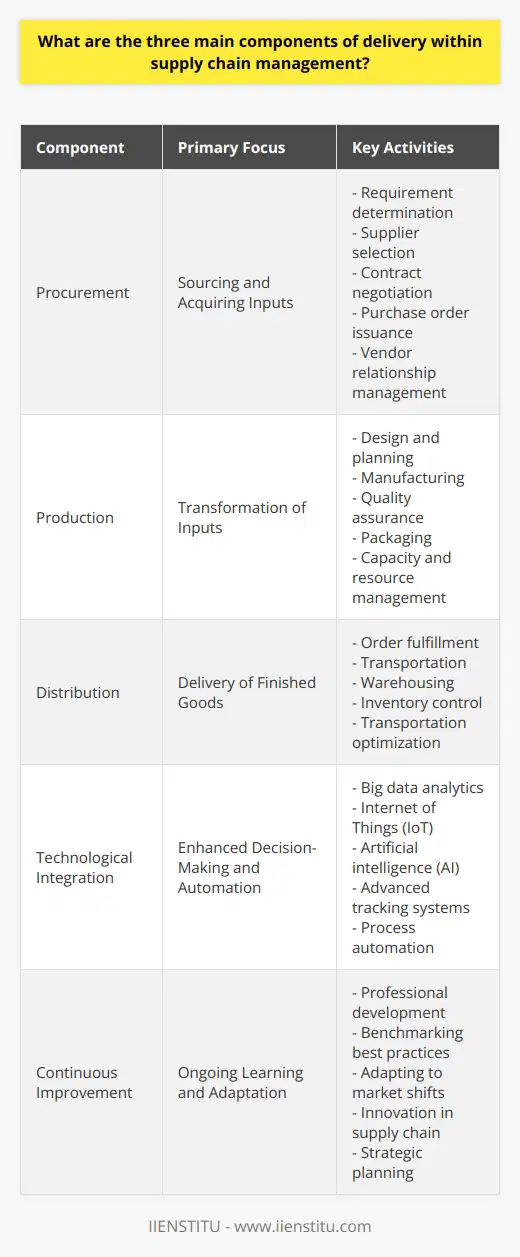
How can technology be utilized for efficient supply chain planning and delivery?
Technology Integration in Supply Chain Planning
Technology can be a crucial enabler for efficient supply chain planning and delivery by facilitating communication, collaboration, and information sharing across different stages of the chain. By integrating advanced technologies like artificial intelligence (AI), machine learning (ML), the Internet of Things (IoT), and big data analytics, it becomes possible to improve forecasting accuracy, optimize inventory levels, reduce costs, and enhance customer satisfaction.
Real-Time Data Analysis and Decision Making
One way technology can be utilized for efficient supply chain planning and delivery is through real-time data analysis. By processing and analyzing large volumes of data generated across the supply chain, organizations can identify patterns and trends that can inform decision making. This enables them to better anticipate demand, plan production schedules, and allocate resources based on predicted requirements, thereby reducing inventory carrying costs and response times.
Enhanced Collaboration and Information Sharing
Technology can also improve supply chain efficiency by enabling better collaboration and communication between supply chain partners. With the adoption of platforms such as blockchain and cloud-based systems, suppliers, manufacturers, and customers can share information in a transparent, secure, and auditable manner. This can help minimize disruptions due to miscommunication, ensuring timely delivery of goods and services.
Automation and Process Optimization
The introduction of automation and robotic process optimization through AI and ML can enable companies to streamline their supply chain operations. By automating repetitive tasks and leveraging self-learning algorithms, organizations can increase efficiency and precision in forecasting, inventory management, and distribution. In turn, this can result in lower costs, better resource allocation, and improved customer experiences.
IoT-Enabled Monitoring and Tracking
The use of IoT devices and sensors can be instrumental in monitoring and tracking goods in real-time. By embedding these devices in the logistics infrastructure, companies can monitor the condition, location, and movement of products throughout the supply chain. This not only ensures accurate and timely delivery, but also helps mitigate risks associated with theft, damage, or spoilage.
In conclusion, the adoption of technology in supply chain planning and management has the potential to revolutionize the way companies plan, operate, and deliver their goods and services. By exploiting advanced technologies such as AI, ML, IoT, and big data analytics, organizations can optimize their supply chain performance, leading to improved efficiency, reduced costs, and enhanced customer satisfaction.
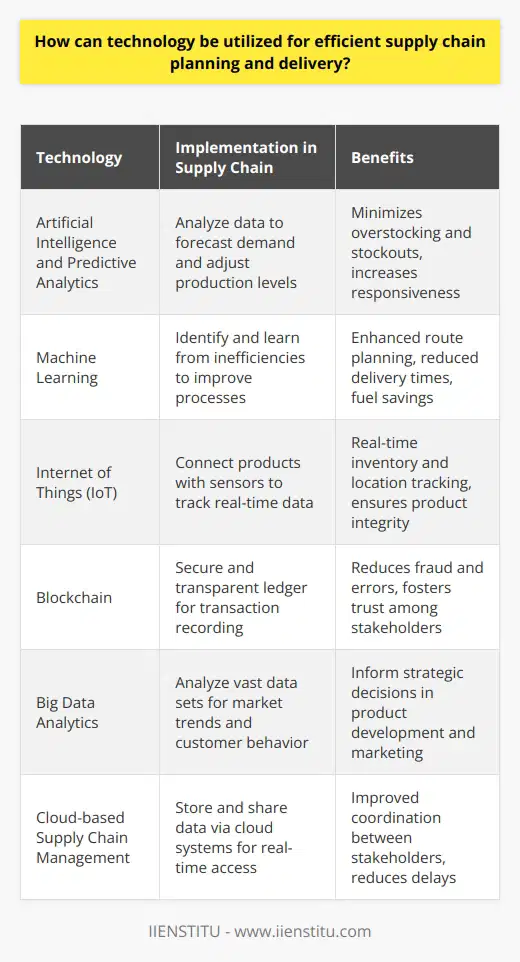
What are some common challenges faced in managing supply chain deliveries and how can they be overcome?
Challenges in Managing Supply Chain Deliveries
Supply Chain Disruptions
One common challenge in managing supply chain deliveries is disruptions caused by unforeseen events such as natural disasters, political instability, and labor strikes. To overcome these disruptions, companies should establish strong contingency plans and diversify their supplier base to mitigate risks associated with a single-sourced supply chain.
Inventory Management
Efficient inventory management is vital for successful supply chain deliveries. Overstocking can result in increased storage costs, while understocking may lead to stockouts and lost sales. Companies should implement effective inventory management systems that utilize data analysis and real-time information to balance demand and supply, reducing costs and better serving customer needs.
Transportation Issues
Transportation issues, such as volatile fuel prices and unpredictable delivery times, pose significant challenges for supply chain managers. To overcome these challenges, companies should optimize transportation routes and modes, utilize technology like GPS tracking to enhance visibility, and collaborate with transportation providers to develop flexible pricing structures.
Poor Supplier Performance
Collaborating with unreliable suppliers can result in delivery delays or inferior quality products, negatively affecting the supply chain. To address this challenge, companies should maintain open communication channels with suppliers, conduct regular evaluation and audits, and establish clear performance metrics to improve supplier accountability.
Lack of Visibility and Integration
A lack of visibility and integration within the supply chain can hinder the ability to manage deliveries effectively. To overcome this issue, companies should invest in digitization and advanced technologies such as blockchain, artificial intelligence, and the Internet of Things (IoT). These tools can improve real-time visibility, enhance collaboration, and streamline processes across the entire supply chain.
Increasing Regulatory and Compliance Requirements
Supply chains can be impacted by ever-changing regulations and compliance requirements. To stay compliant and maintain delivery efficiency, companies should stay informed on regulatory updates, implement robust document management systems, and foster a culture of compliance within their organization.
Conclusion
Managing supply chain deliveries presents numerous challenges, ranging from inventory management to transportation issues. By investing in technology, diversifying suppliers, optimizing transportation, and adhering to regulations, companies can mitigate these challenges, streamline their supply chain, and enhance overall efficiency.
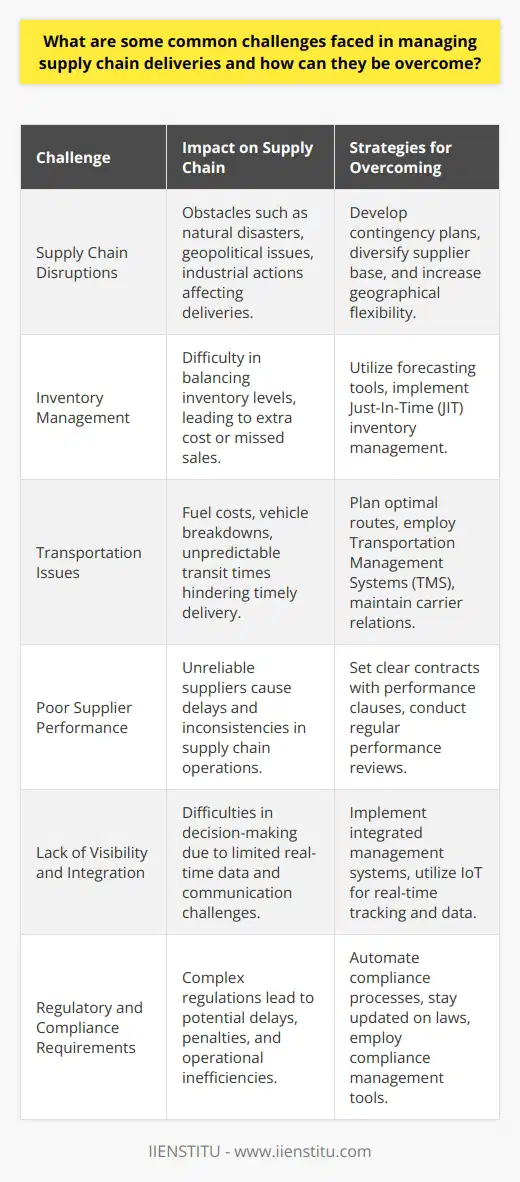
What is the role of forecasting in supply chain planning and delivery?
Role of Forecasting in Planning
Forecasting plays a crucial role in supply chain planning by enabling businesses to anticipate future demand for their products and services. By analyzing historical data, market trends, and external factors, forecasting allows organizations to develop strategic plans for procurement, production, and distribution.
Inventory Management and Procurement Decisions
Effective forecasting helps businesses make informed decisions about inventory levels and procurement. Companies can optimize their inventory by stocking the right amount of products, reducing storage costs and minimizing the risk of stockouts. This also allows them to efficiently allocate resources for purchasing raw materials and goods from suppliers, minimizing costs while ensuring a steady supply.
Production and Capacity Planning
In the manufacturing sector, accurate forecasting is essential for production and capacity planning. By predicting future demand, companies can determine the necessary production levels, equipment, and staffing to meet customer needs. This helps to avoid inefficiencies, such as overproduction, under-utilization of resources, and high operational costs.
Delivery and Distribution Strategies
Forecasting also facilitates the development of delivery and distribution strategies that ensure timely and efficient deliveries to customers. Transportation and logistics decisions can be better planned, selecting the most cost-effective shipping modes and routes. Moreover, distribution centers can be strategically located and adequately stocked, enhancing customer satisfaction and reducing the risk of delays.
Collaboration with Suppliers and Customers
Effective forecasting improves collaboration with suppliers and customers as well. Sharing accurate demand forecasts with suppliers ensures a stable and timely supply of materials and goods, preventing disruptions in the supply chain. Communicating anticipated demand with customers fosters trust and enables better service delivery.
In conclusion, forecasting plays an essential role in supply chain planning and delivery, enabling businesses to optimize inventory management, production capacity, distribution strategies, and collaboration with stakeholders. By accurately anticipating future demand, companies can make strategic decisions that minimize costs, maximize efficiency, and enhance customer satisfaction.
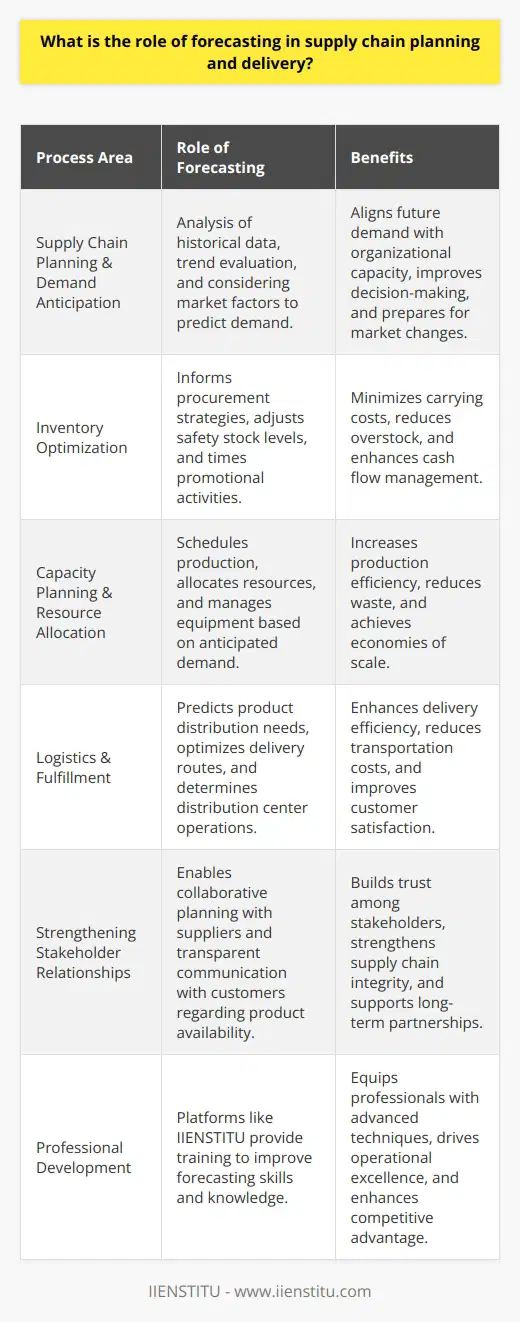
How do supplier relationships impact supply chain management and delivery efficiency?
Impact of Supplier Relationships on Management Efficiency
Supplier relationships are fundamental to supply chain management, as they directly impact the efficiency of delivery operations. A strong and sustainable relationship between suppliers and supply chain managers is essential to ensure smooth flow of goods, services, and information.
Collaboration and Communication
When both parties collaborate and communicate effectively with each other, it leads to improved performance and lower costs. Enhanced information sharing and joint problem-solving can enable better forecasting, demand planning, and inventory management, ultimately enhancing delivery efficiency.
Trust and Commitment
A relationship built on trust and commitment promotes a transparent information exchange, leading to optimization of resources and reduction in lead times. Trust fosters long-term partnerships, which allows supply chain actors to invest in joint initiatives such as technological advancements and risk mitigation strategies, positively impacting delivery efficiency.
Supplier Flexibility
Working with flexible suppliers who can quickly adapt to changes in demand or market conditions enables supply chain managers to rapidly respond to shifting customer needs. This adaptability ensures a consistent supply of products, reduces the probability of stockouts, resulting in efficient and timely deliveries.
Quality Assurance
A strong supplier relationship also ensures consistent quality of products and services. It is crucial for maintaining customer satisfaction and minimizing returns, which can negatively impact delivery efficiency. By working closely with suppliers to address quality concerns, supply chain professionals can create a proactive approach to manage quality-related issues, improving overall performance.
Conclusion
In conclusion, fostering strong supplier relationships is crucial for optimizing supply chain management and enhancing delivery efficiency. An emphasis on collaboration, communication, trust, flexibility, and quality assurance can significantly affect the end-to-end process, leading to improved customer service levels and overall business success.
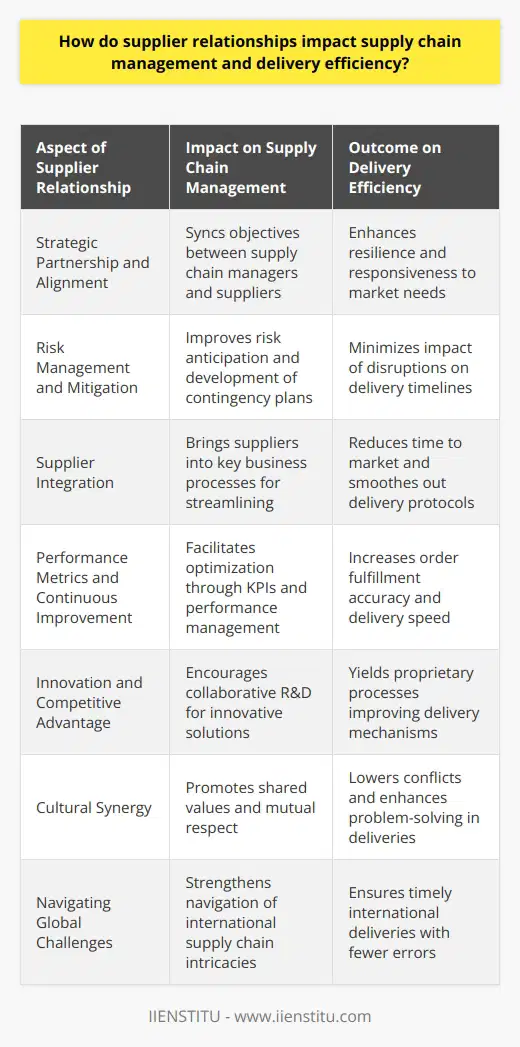
How can sustainability and environmental concerns be incorporated into supply chain planning and delivery?
Incorporating Sustainability in Supply Chain Planning
Sustainability and environmental concerns can be integrated into supply chain planning and delivery by adopting eco-friendly practices. These practices can reduce the negative impact on the environment and improve operational efficiency. The following sections discuss two main aspects for incorporating sustainability in supply chain management: green procurement and greener transportation.
Green Procurement
Companies can make environmentally-conscious decisions by selecting suppliers that demonstrate sustainable production processes. This process, known as green procurement, involves evaluating the environmental performance of suppliers and incorporating eco-friendly criteria into purchasing decisions. Suppliers can be assessed based on their method of production, waste management practices, and energy use efficiency. By engaging in green procurement, businesses can make supply chains more sustainable and decrease their carbon footprints.
Greener Transportation
A significant part of a supply chain's environmental impact comes from transportation. Companies can mitigate this issue by opting for greener transportation alternatives, such as electric vehicles, biodiesel, or hybrid trucks. Additionally, businesses can improve their transportation logistics by optimizing routes, reducing idling, consolidating shipments, and using intermodal transportation when possible. These strategies not only reduce greenhouse gas emissions but can also lower operational costs through fuel savings and increased efficiency.
In conclusion, businesses must actively incorporate sustainability and environmental concerns into their supply chain planning and delivery. This can be accomplished through green procurement and greener transportation practices, leading to a reduced impact on the environment and enhanced operational efficiency. By adopting these eco-friendly strategies, companies can contribute to long-term sustainability while reaping the added benefits of cost savings and improved performance.
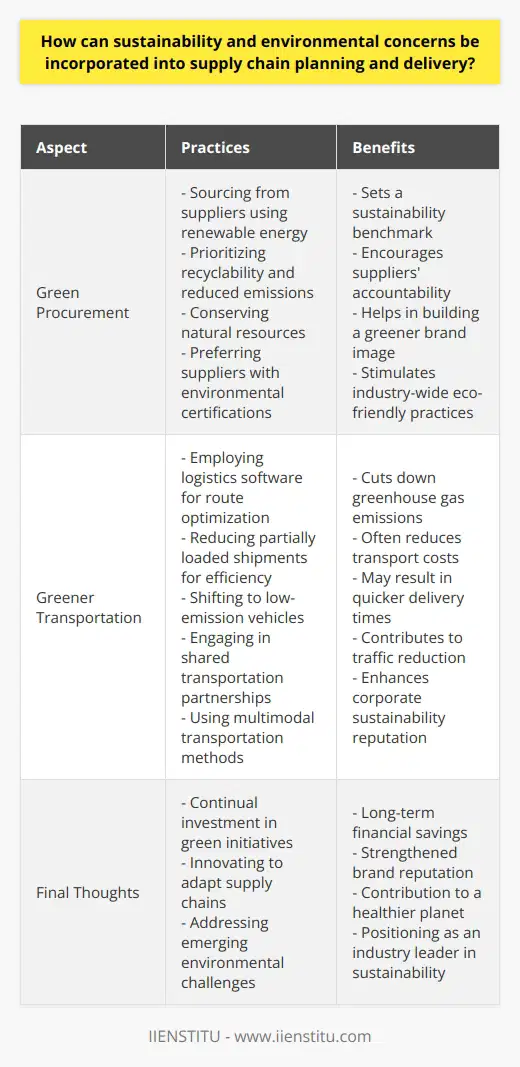
What are the key principles for designing an effective supply chain planning process?
Key Principles for Effective Supply Chain Planning
Demand Forecasting and Analysis
A primary principle for designing an effective supply chain planning process involves demand forecasting and analysis, which entails predicting customer demands with the help of historical data and market trends. Accurate forecasts facilitate better resource allocation, inventory management, and production scheduling, leading to a more efficient supply chain.
Coordination and Collaboration
Effective communication and collaboration among stakeholders, such as suppliers, manufacturers, and logistics providers, are crucial for a seamless supply chain planning process. Sharing information and working collectively towards common goals helps mitigate the risks of disruptions and ensures that all parties respond promptly to any changes in the supply chain.
Inventory Management and Optimization
Optimizing inventory levels is another critical aspect of effective supply chain planning. Balancing the stock levels to avoid excess or shortage allows for cost reduction, improved customer satisfaction, and minimized obsolescence. The implementation of just-in-time inventory strategies and establishing safety stock levels contribute to maintaining optimal inventory levels throughout the supply chain.
Integration of Technology
Utilizing advanced technologies, such as artificial intelligence, machine learning, and data analytics, improve the supply chain planning process by providing real-time insights, identifying patterns and trends, and making data-driven decisions. The integration of technology ensures the continuous improvement of the planning process, enabling organizations to adapt to dynamic market conditions effectively.
Visibility and Transparency
Creating a transparent and visible supply chain planning process enables stakeholders to track and monitor inventory and order statuses and make informed decisions based on accurate and timely information. Visibility fosters trust, reduces uncertainty, and contributes to the efficiency of the planning process, mitigating risks and disruptions.
Continuous Improvement and Adaptability
An effective supply chain planning process must be flexible and adaptable to ever-changing market conditions and customer preferences. Incorporating a continuous improvement mindset ensures that organizations consistently evaluate and refine their planning process, identify gaps and inefficiencies, and implement necessary changes to maintain a competitive advantage in the market.
In summary, designing an effective supply chain planning process requires consideration of key principles, such as demand forecasting, collaboration, inventory management, technology integration, visibility, and continuous improvement. By incorporating these principles, organizations can achieve a more efficient and agile supply chain, ultimately resulting in increased customer satisfaction, reduced costs, and overall operational excellence.
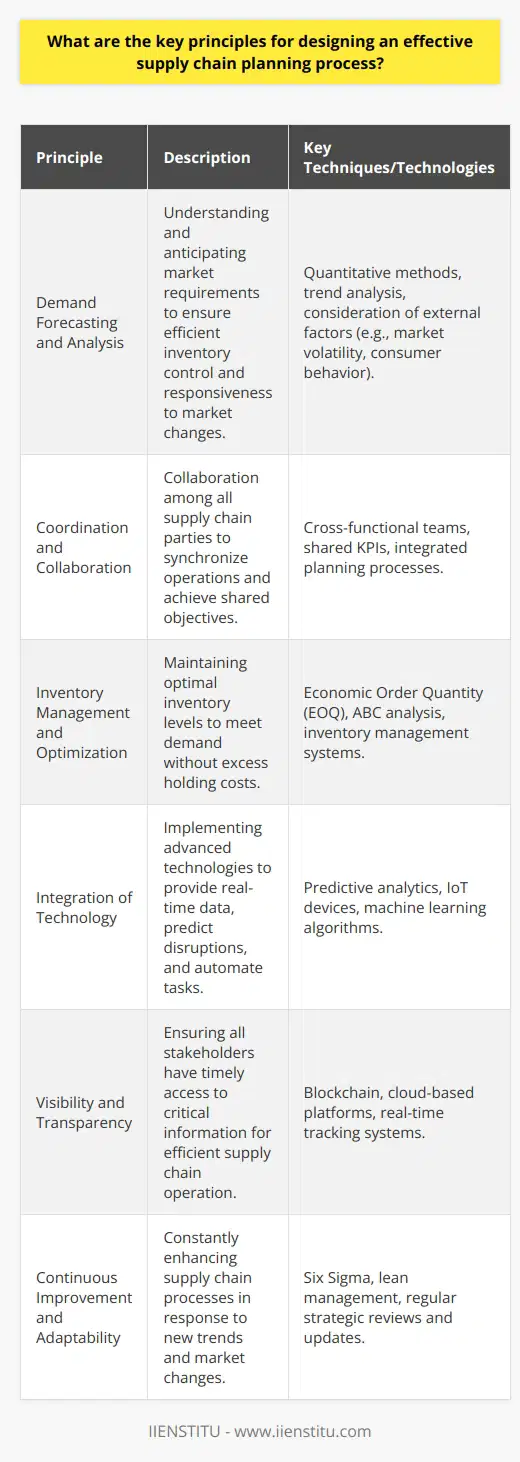
How does demand forecasting contribute to overall supply chain planning and delivery efficiency?
Demand Forecasting in Supply Chain Planning
Accurate demand forecasting plays a crucial role in enhancing supply chain planning and delivery efficiency. By predicting customer demand, organizations can make informed decisions about inventory management, production scheduling, and distribution strategy. This process enables businesses to reduce costs, increase customer satisfaction, and ultimately, achieve a competitive advantage in the market.
Optimal Inventory Management
Effective demand forecasting allows companies to maintain optimal inventory levels. This minimizes the risk of stockouts or holding excessive inventory, both of which can result in lost sales and increased costs. Consequently, efficient inventory management enables businesses to meet customer demands in a timely manner and reduce the expenses associated with excess stock, storage, and obsolescence.
Improved Production Scheduling
By anticipating the demand for a particular product or service, organizations can plan their production schedules more effectively. This enables them to allocate resources efficiently, reduce lead times, and avoid overproduction or underproduction. As a result, companies can achieve cost savings and ensure that products are available when customers require them.
Enhanced Distribution Strategy
Demand forecasting contributes to the development of an effective distribution and logistics strategy. This helps companies to determine the most appropriate modes of transportation, warehousing, and delivery routes. Overall, this increases the efficiency of the supply chain and allows businesses to deliver products faster and at a lower cost to their customers.
Adaptation to Market Changes
In an increasingly competitive business environment, understanding market dynamics is essential for businesses. Demand forecasting allows organizations to quickly respond to fluctuations in both consumer behavior and external factors, such as economic conditions or changes in competition. This proactive approach ensures that companies remain competitive and maximize profitability.
In conclusion, demand forecasting serves as a foundation for successful supply chain planning and delivery efficiency. By accurately predicting customer demand, organizations can optimize inventory management, improve production scheduling, enhance distribution strategy, and adapt to market changes. Ultimately, this enables businesses to achieve a higher level of customer satisfaction while minimizing costs and leveraging a competitive advantage.
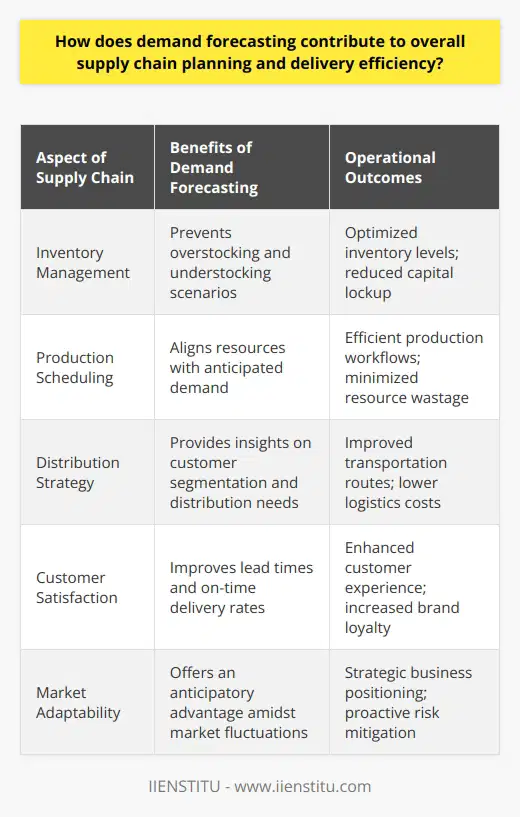
In what ways can risk management strategies be integrated with supply chain planning to ensure smooth delivery operations?
Risk Assessment and Identification
To implement risk management strategies within supply chain planning, businesses must first assess and identify potential risks. By conducting a comprehensive analysis of their supply chain, companies can pinpoint areas of vulnerability, such as supplier reliability, transportation disruptions, or production bottlenecks. This information enables managers to develop targeted strategies to mitigate these risks and maintain smooth delivery operations.
Risk Mitigation and Contingency Planning
Supply chain managers must develop a proactive approach towards mitigating potential risks. This may involve identifying alternative suppliers, establishing backup transportation options, or maintaining buffer stocks to address unexpected disruptions. It is essential to have contingency plans in place that can be quickly executed in response to unforeseen events. The ability to adapt quickly and efficiently to changing circumstances enables companies to minimize the impacts of disruptions on their supply chain operations.
Collaboration and Information Sharing
Collaboration among different stakeholders is vital for successful risk management integration. By establishing strong relationships with suppliers, logistics providers, and other partners, companies can gain better visibility into their supply chain processes. Sharing information and resources openly can lead to more effective risk mitigation strategies and enhanced supply chain resilience. Furthermore, engaging in collaborative problem-solving can foster innovation and improve overall supply chain performance.
Continuous Monitoring and Improvement
To ensure the ongoing effectiveness of risk management strategies, companies must engage in continuous monitoring and assessment of their supply chain. Gathering data on supplier performance, delivery times, and other KPIs can help identify trends and uncover areas requiring adjustment. Regular auditing and review of risk management processes can also enable companies to refine their strategies, incorporate new research or technologies, and learn from past experiences. This iterative approach to risk management fosters continuous improvement and supports smooth delivery operations.
In conclusion, integrating risk management strategies with supply chain planning is essential for maintaining smooth delivery operations. By assessing and identifying potential risks, implementing proactive mitigation measures, fostering collaboration, and continuously monitoring and improving the process, companies can effectively manage their supply chain risks and ensure consistent and timely delivery of goods and services to their customers.
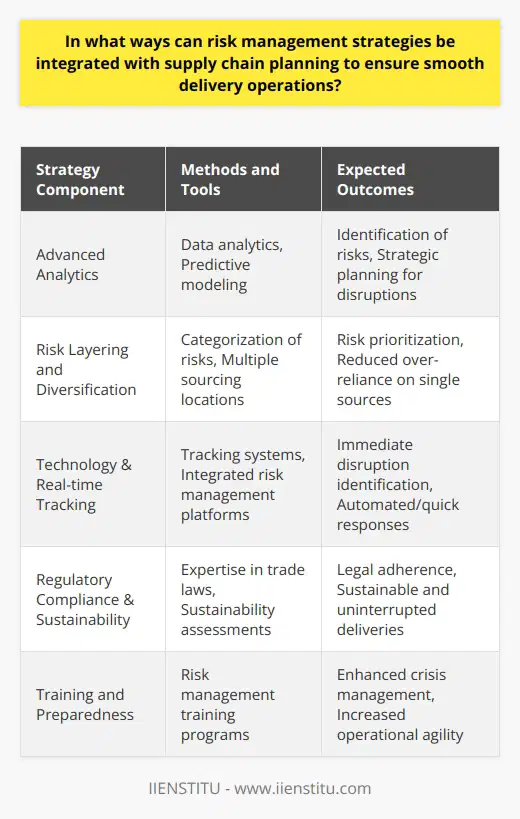
What is the process of delivery in supply chain management?
Delivery Process in Supply Chain Management
Understanding the Delivery Process
The process of delivery in supply chain management comprises multiple steps adapted to ensure timely and accurate delivery of products to end-users. The delivery process is a critical aspect of supply chain management that directly impacts customer satisfaction and the overall success of a business. The following sections will explain specific steps involved in the delivery process within the context of supply chain management.
Order Processing
The delivery process begins with order processing. This stage essentially enables the proper execution of an order, and reduces the time between order placement by customers and product delivery. Order processing entails receipt of orders, documentation, preparation, storage, and subsequent release for delivery.
Inventory Management
Inventory management is an essential component of the delivery process. It ensures the availability of stock, optimizes storage conditions, and minimizes handling costs. Efficient inventory management balances the supply of products with demand to avoid stockouts, overstocking, and wasted resources.
Transportation and Logistics
An effective delivery process relies on optimal transportation and logistics management. Transportation refers to the physical movement of products from production facilities to distribution centers, while logistics involves organizing the transport, storage, and handling of goods along the supply chain. Proper integration of transportation and logistics ensures timely and cost-effective delivery of products.
Last Mile Delivery
Last mile delivery refers to the final step in the delivery process — transporting the product from the distribution hub to the end-user. This phase is vital in meeting customer expectations, enhancing satisfaction, and boosting a company's competitiveness. Efficient last-mile delivery options include traditional delivery methods, such as carriers or postal services, as well as modern approaches, such as drones or click-and-collect services.
Reverse Logistics
Reverse logistics is the process of returning products from end-users to manufacturers or retailers, typically in the case of product recalls, returns, or recycling efforts. It is crucial for businesses to handle reverse logistics effectively to maintain customer satisfaction, recover value, and minimize losses.
In conclusion, the delivery process in supply chain management consists of several stages, including order processing, inventory management, transportation and logistics, last-mile delivery, and reverse logistics. Each phase contributes to the overall efficiency of the supply chain and directly impacts customer satisfaction. Effective management of the delivery process is vital for businesses to thrive in today's competitive market.
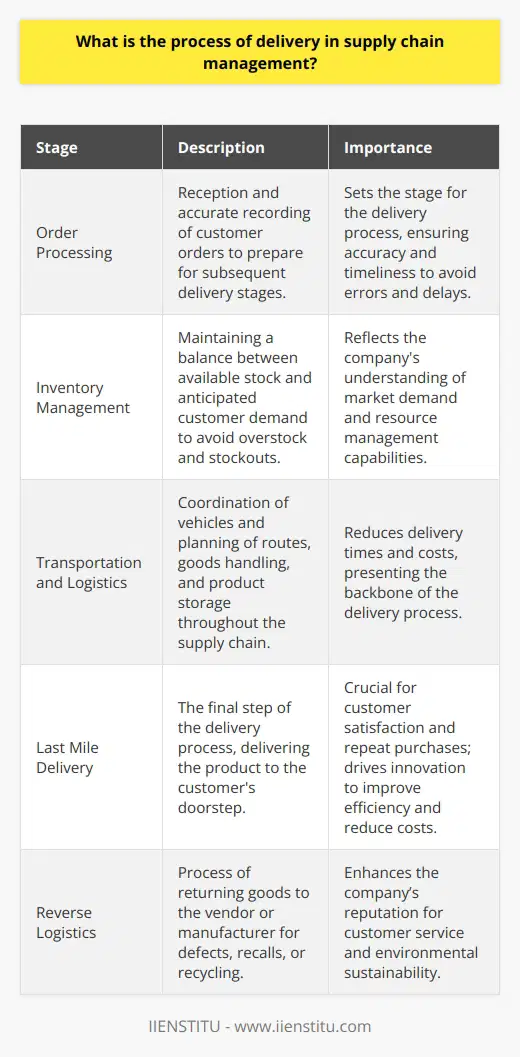
How does inventory management influence the effectiveness of delivery within supply chain management?
Impact on Delivery Efficiency
Inventory management plays a crucial role in enhancing the effectiveness of delivery within supply chain management. By ensuring appropriate stocking levels, businesses can meet varying customer demands and avoid delays or stockouts. Proper inventory control enables companies to maintain a balance between overstocking and understocking, reducing costs associated with unsold goods and storage.
Reduced Lead Times
Efficient inventory management systems minimize lead times by streamlining the flow of products between suppliers and customers. Shorter lead times result in quicker deliveries, enhancing customer satisfaction and fostering repeat business. Consequently, companies can improve their competitive edge through timely delivery, propelling business growth and increased market share.
Real-time Tracking and Visibility
Leveraging advanced technologies, such as the Internet of Things (IoT) and Artificial Intelligence (AI), inventory management systems provide real-time visibility into the entire supply chain. This transparency allows businesses to track products from the point of origin to the final destination, reducing the chances of lost or misplaced items. Additionally, real-time tracking simplifies the process of identifying and addressing issues, such as shipment delays or damaged items, before they escalate and affect the delivery process.
Optimized Distribution Routes
Inventory management also involves route optimization, ensuring that products reach their intended destination in the shortest time possible. Optimally planned routes not only save time but also fuel, labor, and transportation costs. Efficient route planning contributes to reduced delivery times, resulting in satisfied customers and stronger relationships between businesses and their clients.
Improved Demand Forecasting
By analyzing historical sales data and market trends, inventory management systems aid in demand forecasting, allowing companies to anticipate customer needs and adjust inventory levels accordingly. Accurate demand forecasting decreases the likelihood of stockouts, leading to improved delivery performance and increased customer satisfaction. Moreover, it enables businesses to utilize warehouse space effectively and minimize costs associated with holding excess inventory.
In conclusion, inventory management significantly impacts the effectiveness of delivery within supply chain management, ensuring timely deliveries that meet customers' expectations. As a result, businesses can maintain a competitive edge, increase customer satisfaction, and ultimately achieve sustainable growth.
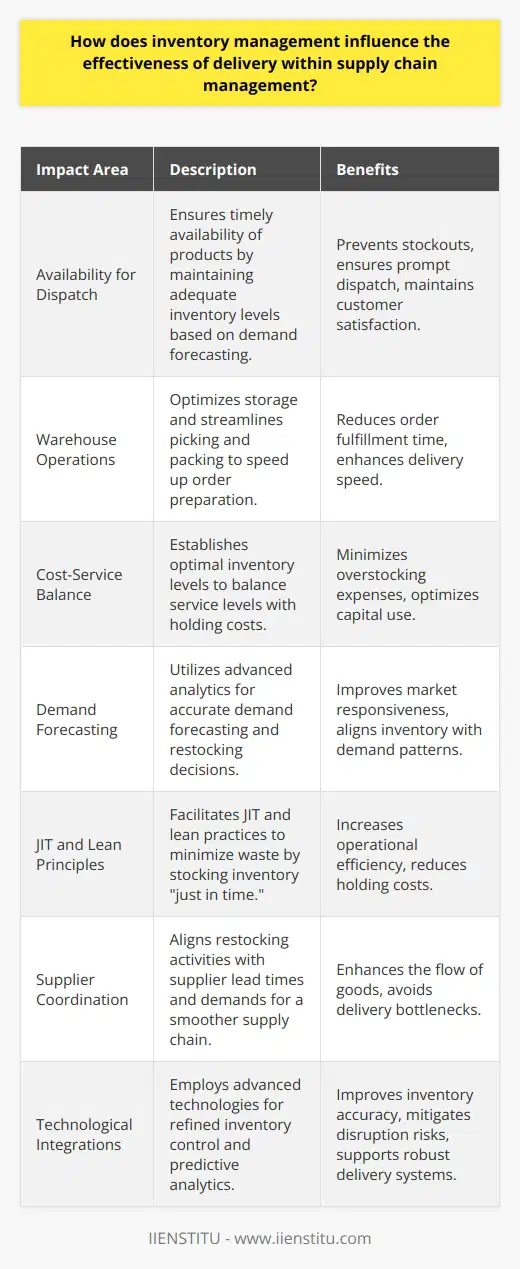
How can lean principles be applied to improve efficiency in supply chain planning and delivery processes?
Lean Principles in Supply Chain Planning
The application of lean principles can significantly enhance supply chain planning and delivery processes by focusing on value-added activities and minimizing waste. To begin with, implementing a value stream mapping approach ensures that every step within the supply chain is thoroughly examined in the context of the end-user's requirements. By mapping the flow of materials and information, organizations can identify inefficiencies, bottlenecks, and redundancies, paving the way for continuous improvement opportunities.
Demand-driven Planning and Forecasting
Adopting a demand-driven planning and forecasting process allows companies to respond promptly to fluctuations in customer requirements. Forecast accuracy can be improved by utilizing real-time data, thereby reducing inventory levels and minimizing the risk of stock-outs. Concurrently, implementing a pull-based replenishment system ensures that organizations do not needlessly overproduce goods, eliminating waste and improving inventory turnover.
Supplier Collaboration and Integration
Establishing effective collaboration and integration with suppliers becomes vital in a lean supply chain. This creates a seamless flow of information and materials, promoting transparency and trust among stakeholders. Such collaboration can be enhanced via supplier development programs, joint scorecards, and shared objectives, which facilitate mutual understanding of expectations and continuous improvement. In addition, leveraging digital technologies and industry standards assists in streamlining communications and aligning processes throughout the supply chain.
Lean Logistics and Transportation
Embracing lean principles in logistics and transportation management can result in reduced lead times, improved service levels, and decreased costs. By consolidating shipments, optimizing routing, and cross-docking whenever possible, organizations minimize wasted time and resources in transportation. Furthermore, investing in reliable transportation partners and leveraging technology for real-time visibility supports better decision-making and reduces the likelihood of disruptions.
Performance Measurement and Continuous Improvement
Lastly, a paramount aspect of lean supply chain management involves the ongoing monitoring, analysis, and optimization of performance metrics. By establishing key performance indicators (KPIs) that align with the organization's strategic objectives, companies can ensure that their supply chain functions effectively and efficiently. Regular reviews of these metrics allow for assessment of progress and identification of areas of improvement, supporting a culture of continuous learning and refinement.
In conclusion, adopting lean principles in supply chain planning and delivery processes fosters efficiency and agility throughout the organization. By improving demand management, enhancing collaboration, optimizing logistics, and rigorously measuring performance, companies can achieve a sustainable competitive advantage and better serve their customers.
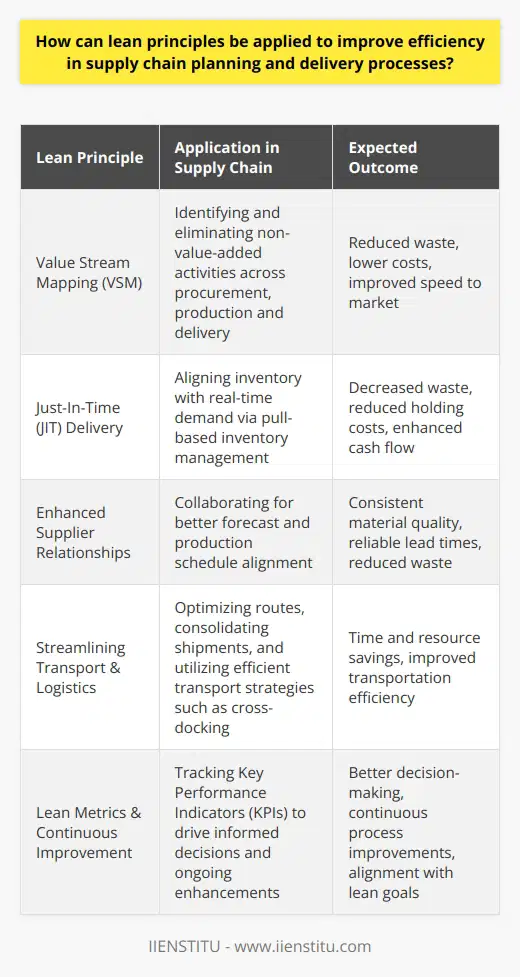
What is the delivery process in supply chain management?
Delivery Process in Supply Chain Management
Overview of Delivery Process
The delivery process in supply chain management refers to the efficient and effective movement of goods and services from the point of production or manufacturing to the point of consumption. This comprehensive function entails the coordination and integration of various activities, including transportation, warehousing, and inventory control, all aimed at fulfilling customer orders as promptly and accurately as possible.
Transportation Management
A critical component of the delivery process is transportation management, which involves selecting the most cost-effective and time-efficient mode of transport for moving goods. This can include road, rail, air, or sea transportation, or a combination of these modes, depending on factors such as the type of goods being transported, distances involved, and time constraints. Transportation management also involves route planning and coordination with carriers to ensure timely delivery while minimizing shipping costs.
Warehousing and Inventory Control
Effective warehousing and inventory control practices are essential in streamlining the delivery process. Warehousing refers to the process of storing goods temporarily until they are required for delivery, while inventory control focuses on tracking and managing stock levels to ensure the timely fulfillment of customer orders. These activities entail managing storage facilities, monitoring stock levels, and implementing order-picking and packing strategies to speed up the delivery process.
Order Management and Fulfillment
The order management and fulfillment aspect of the delivery process involves processing customer orders and ensuring that the right products are delivered to the correct locations and within the specified timeframes. This requires effective communication and coordination between various departments, including sales, customer service, and logistics teams. The use of order management software can streamline this process, allowing for efficient information sharing and order tracking.
Technological Applications in Delivery Process
Incorporating advanced technologies into the delivery process can optimize supply chain operations and enhance overall delivery performance. The use of warehouse management systems (WMS), transportation management systems (TMS), and enterprise resource planning (ERP) software enables real-time visibility, data-driven decision-making, and improved coordination among various supply chain stakeholders. Additionally, the implementation of technologies such as radio frequency identification (RFID) and global positioning system (GPS) aids in tracking goods throughout the delivery process, resulting in increased accuracy and efficiency.
In conclusion, the delivery process in supply chain management encompasses a wide range of activities that are crucial to ensure the prompt and accurate delivery of goods and services to customers. Effective transportation management, warehousing and inventory control, order management and fulfillment, as well as the integration of technological solutions, contribute significantly to streamlining this crucial process.
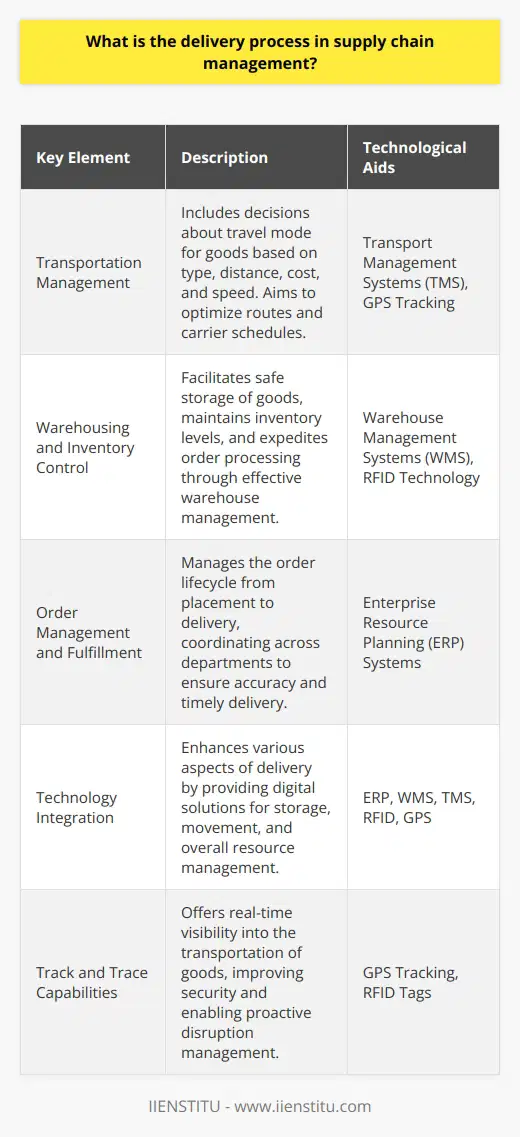
How to do planning in supply chain management?
Supply Chain Management Planning Process
In supply chain management, planning plays an essential role in ensuring that all supply chain-related activities are carried out efficiently and effectively. To do planning in supply chain management, the following steps can be taken:
Define the objectives: Clearly state the goals of the supply chain, including time and cost optimization, service levels, and customer satisfaction. These objectives will guideline the planning process.
Develop a supply chain strategy: Based on the defined objectives, create a comprehensive strategy that balances efficiency, cost-effectiveness, and risk management.
Conduct a demand forecast: Accurate demand forecasting is crucial for effective planning. Analyze historical data, market trends, and customer feedback to predict future demand patterns.
Assess inventory levels: Regularly evaluate your current inventory levels and determine the optimal amount to hold based on demand forecasts and lead times.
Establish order and shipment plans: Determine when to place orders, shipment schedules, and quantities to ensure a smooth flow of products through the supply chain.
Coordinate with suppliers and partners: Collaborate with suppliers, carriers, and other supply chain partners to effectively communicate plans, share information, and monitor performance.
Monitor and control operations: Regularly evaluate the performance of the supply chain to identify deviations from the plan and make necessary adjustments in real-time.
Continuously improve the supply chain: Regularly review and analyze supply chain performance to identify areas for improvement and implement changes as needed.
In conclusion, effective planning in supply chain management involves setting clear objectives, developing a comprehensive strategy, and continuously monitoring, evaluating, and improving operations. By following these steps, companies can achieve an efficient and effective supply chain, resulting in enhanced customer satisfaction and competitive advantage.

What are the requirements for effective supply chain planning in delivery?
**Understanding Customer Needs**
Effective supply chain planning in delivery starts with understanding customer needs and establishing clear goals to meet them. To achieve this, companies must analyze market trends, demand patterns, and potential disruptions in order to predict future demands accurately and adjust supply chain processes accordingly.
**Collaboration and Communication**
Collaboration between different stakeholders, such as suppliers, manufacturers, and retailers, is crucial for successful supply chain planning. Sharing information and aligning strategies ensures that all parties are working toward the same goal, which leads to increased efficiency and reduced risk of supply chain disruptions.
**Adaptability and Flexibility**
Supply chain planning should be adaptable and flexible enough to accommodate changes in market demand or unforeseen events that may affect delivery. This involves continuous monitoring of supply chain performance and making adjustments based on real-time data and analytics.
**Inventory Management**
Optimal inventory management is essential for effective supply chain planning. Companies need to strike a balance between stocking too much inventory, which can result in higher carrying costs and obsolescence, and having too little, which can cause stock-outs and lost sales. This can be achieved through accurate demand forecasting, efficient replenishment strategies, and monitoring inventory levels in real-time.
**Incorporating Technology**
Incorporating technology into supply chain planning allows companies to increase the efficiency and accuracy of their processes. Advanced software solutions can provide real-time visibility into inventory levels, transportation schedules, and supplier performance, as well as facilitate communication and collaboration between stakeholders. Additionally, leveraging data analytics and machine learning can enhance forecasting and decision-making capabilities.
**Risk Management**
An effective supply chain planning process must include strategies for managing risks and uncertainties. This includes identifying potential sources of disruption, such as natural disasters or political instability, and developing contingency plans to mitigate their impact on delivery. Risk management also involves diversifying supplier networks and implementing proactive monitoring systems to detect issues before they escalate.
**Performance Measurement and Continuous Improvement**
To ensure the effectiveness of supply chain planning, companies must regularly assess their performance and identify areas for improvement. This can involve tracking key performance indicators, such as on-time delivery rates, order accuracy, and lead times, as well as conducting regular audits and reviews. By focusing on continuous improvement, companies can optimize their supply chain planning processes and enhance their overall delivery performance.

What are the five key areas of planning in supply chain management?
**Overview of Key Areas**
Effective supply chain management is vital to the success of an organization, and proper planning is essential to ensure that the flow of goods and services is efficient and accurate. Five key areas of planning in supply chain management include demand planning, supply planning, production planning, distribution planning, and performance management.
**Demand Planning**
In demand planning, organizations gather, analyze, and predict the requirements of customers, ensuring that adequate resources and inventory are available to fulfill their needs. This involves collaborative efforts between various stakeholders, such as sales, marketing, and finance, to provide accurate forecasts and adjust operations accordingly.
**Supply Planning**
Supply planning is essential to optimize resources and costs, ensuring that necessary products and materials are available when needed without excess or insufficient inventory. This can require balancing variables such as lead times, order quantities, and supplier reliability, helping to prevent disruptions in the supply chain.
**Production Planning**
Production planning focuses on scheduling manufacturing processes to meet customer requirements while effectively utilizing available equipment, labor, and materials. By aligning production capacity with demand, organizations can increase efficiency, minimize waste, and reduce overall manufacturing costs.
**Distribution Planning**
In distribution planning, the primary goal is to determine the most efficient means to deliver goods and services to customers in a timely manner. This involves the selection of suitable transportation modes, routing, and warehousing strategies and collaborating with logistics partners to streamline the distribution process and optimize costs.
**Performance Management**
Lastly, performance management is vital to continuously assess and improve supply chain operations. By monitoring key performance indicators (KPIs), organizations can identify areas of inefficiency, develop improvement strategies, and adjust processes accordingly. This helps to ensure ongoing success and competitive advantage.
In summary, planning in supply chain management encompasses demand planning, supply planning, production planning, distribution planning, and performance management. These five key areas are crucial for ensuring the efficiency and effectiveness of supply chain operations, ultimately paving the way for organizational success.
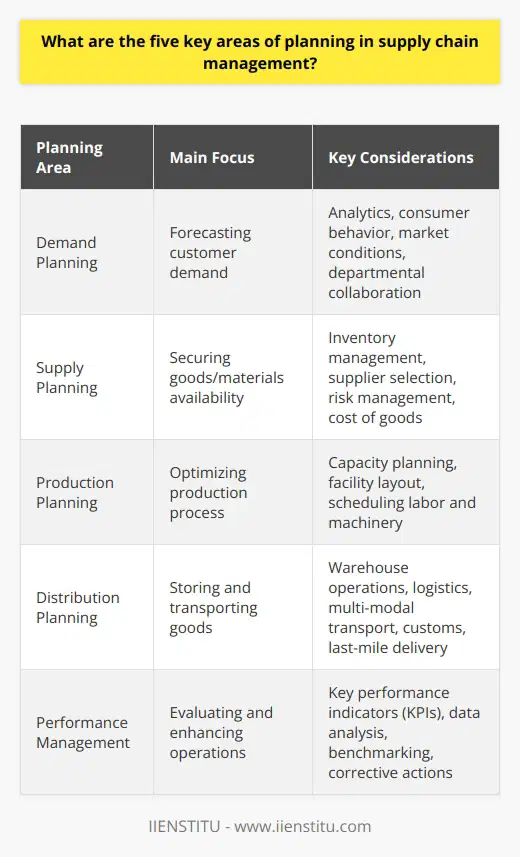
How do financial considerations influence supply chain planning and delivery strategies?
Financial Factors in Supply Chain Planning
Financial considerations play a significant role in shaping supply chain planning and delivery strategies. Companies must assess costs and potential profits across different stages of the supply chain, thus influencing their decisions and overall approach.
Direct Costs and Profit Margins
Firstly, direct costs such as raw materials, labor, and transportation significantly impact supply chain planning. Companies aim to minimize expenses while maintaining or increasing profit margins. Therefore, they often evaluate suppliers based on cost-effectiveness, product quality, and reliability.
Inventory Management
Another financial aspect to consider in supply chain planning is inventory management. Companies strive to find a balance between holding excessive inventory that incurs high carrying costs and maintaining adequate stock levels to meet demand. Efficient inventory management helps businesses save costs and improve cash flow.
Risk Management
Financial risks in the supply chain, such as fluctuating exchange rates, price volatility, and credit risks, affect planning and delivery strategies. Companies must incorporate risk management techniques to hedge against possible losses and ensure financial stability throughout the supply chain.
Demand Forecasting and Capital Expenditure
Accurate demand forecasting is essential to make informed decisions about capital expenditure for production and distribution facilities. Overestimating demand may lead to excess capacity, while underestimating demand can result in lost sales opportunities. Companies must scrutinize market trends and customer preferences to allocate resources efficiently and optimize financial performance.
Financing Strategies
Lastly, financing strategies for the supply chain directly impact planning and delivery. Companies can choose between raising capital through debt or equity, influencing their financial flexibility and growth potential. Additionally, the working capital management, including accounts receivable and payable, is crucial for maintaining a healthy cash flow and supporting supply chain activities.
In conclusion, financial considerations are deeply intertwined with supply chain planning and delivery strategies. Direct costs, inventory management, risk management, demand forecasting, and financing strategies all impact the overall financial performance and stability. Companies must carefully consider these factors to develop efficient and profitable supply chain management.
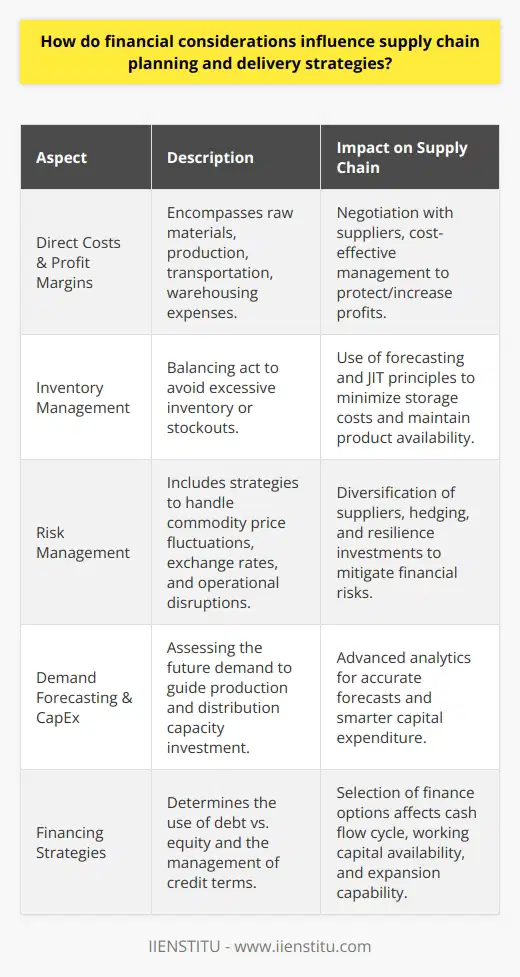
How do strategic sourcing and procurement practices impact supply chain management planning and delivery success?
Strategic Sourcing and Procurement Practices
Strategic sourcing and procurement practices play a critical role in the success of supply chain management by optimizing the acquisition of goods and services. These practices involve the analysis of suppliers, market trends, and cost structures, leading to informed decision-making. As a result, organizations can reduce acquisition costs, improve supplier relationships, and enhance the overall value of their supply chain operations.
Reduction of Acquisition Costs
By implementing strategic sourcing, organizations can identify procurement opportunities to minimize purchasing costs. Such opportunities include volume discounts, shipping economies, or alternative suppliers who offer better pricing. These practices allow companies to streamline their procurement processes and generate savings that contribute to their overall financial performance.
Improvement of Supplier Relationships
Establishing a strong relationship with suppliers is crucial for efficient supply chain management. Strategic procurement practices help organizations collaborate with their suppliers, ensuring that the flow of goods and services is smooth and uninterrupted. Strong relationships also encourage open communication channels and provide access to suppliers' market intelligence, which can offer valuable insights into industry trends.
Enhancement of the Supply Chain's Value
Strategic sourcing not only streamlines procurement processes but also contributes to increasing the value of an organization's supply chain. It emphasizes assessing the total cost of ownership (TCO) for different procurement categories, which includes factors like acquisition costs, transportation fees, and other hidden expenses. Examining the TCO and adopting a holistic approach to procurement decisions ensure that organizations secure the best value for their investments.
Increased Adherence to Compliance and Risk Management
Procurement practices must comply with relevant regulations, industry standards, and environmental considerations. Strategic sourcing involves analyzing potential suppliers' compliance status and risk management capabilities, mitigating the risks of supplier disruptions or non-compliance penalties. Effective risk management strategies and regulatory compliance contribute to the overall stability of a supply chain.
In conclusion, strategic sourcing and procurement practices are crucial components of an organization's supply chain management strategy. By focusing on reducing acquisition costs, improving supplier relationships, enhancing the supply chain's value, and maintaining compliance and risk management, organizations can optimize their procurement operations, ultimately leading to more successful supply chain management planning and delivery.
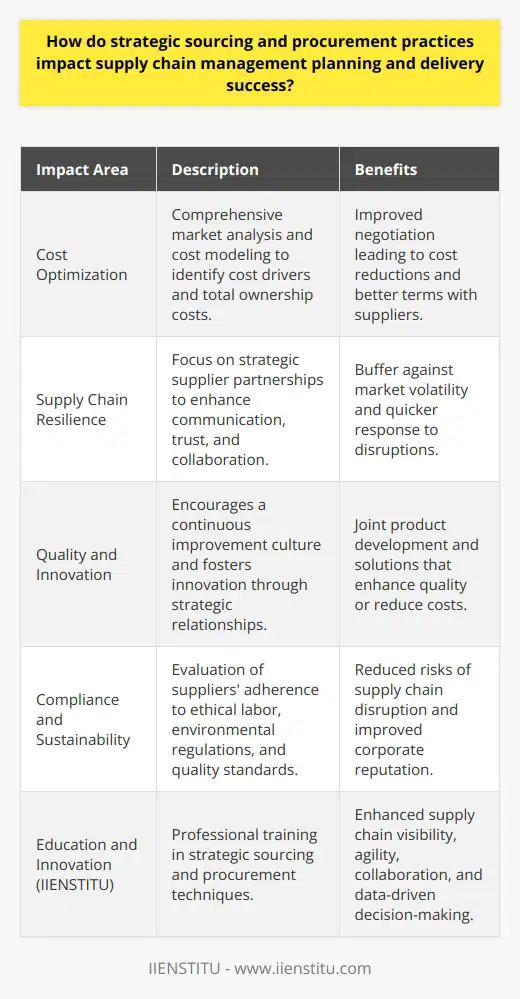
What are the essential factors to consider when developing a supply chain management plan?
Understanding Supply Chain Components
When developing a supply chain management plan, understanding the components of the supply chain is a fundamental step. This includes the suppliers, manufacturing centers, warehouses, distribution centers, and retail outlets.
Supply Chain Design and Planning
The next factor to consider is the supply chain design. This involves deciding on the number of suppliers, the quality of products, production capacity, and distribution methods. Proper planning is crucial to ensure that supply chain operations align with business objectives.
Assessment of Supply Chain Risks
Additionally, risk management plays a pivotal role in supply chain planning. This involves identifying potential risks in supply-chain processes and creating strategies to mitigate them. The aim is to institute proactive measures to prevent disruptions in supply chain operations.
Upgrading Technology Systems
Employing the right technology is another significant factor in supply chain planning. Technology enhances efficiency and facilitates automation of supply chain processes. Consequently, we need to select the appropriate technology based on the specific needs of our supply chain.
Building Strong Supplier Relationships
Building and maintaining strong relationships with suppliers is a critical aspect of effective supply chain management. Cultivating trust and collaboration with suppliers can lead to improvements in product quality and delivery times, underpinning the overall success of the supply chain.
Sustainability In Supply Chain
Lastly, sustainability should take center stage in supply chain planning. This includes considerations on environmental impact, social justice, and economic viability. Incorporating sustainability in supply chain management can mitigate environmental risks and improve brand reputation.
In conclusion, a comprehensive supply chain management plan should consider diverse elements, including supply chain components, supply chain design, risk management, technology, supplier relationships, and sustainability. These factors provide a robust foundation for developing an efficient and effective supply chain.
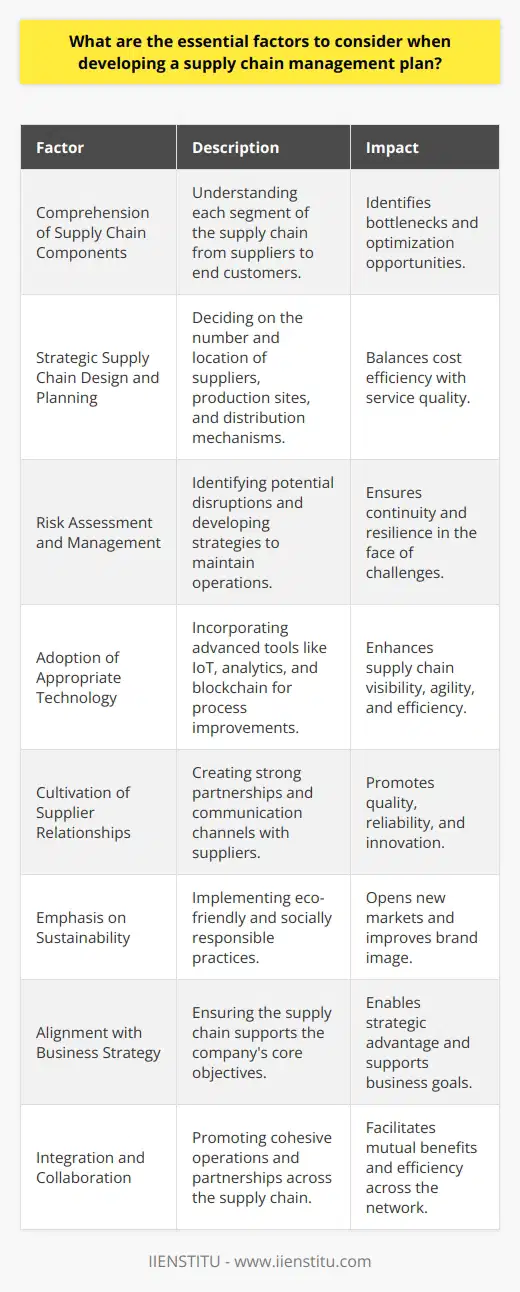
How do transportation and logistics decisions in supply chain management influence delivery efficiency?
Impact of Transportation Decisions
Transportation plays a critical role in supply chain management, directly influencing delivery efficiency. Decisions concerning modal choice, route selection, and carrier selection substantially affect delivery time. Adopting the appropriate transportation mode can expedite shipment processes, thereby enhancing delivery efficiency.
Route Optimization
Moreover, effective route selection can shorten transportation time. It reduces unnecessary detours and leads to more timely deliveries. Intelligent route optimization serves to remove inefficiencies and can lead directly to improved delivery times.
Carrier Selection
Carrier selection also affects delivery efficiency. Choosing a reliable carrier with a history of punctuality and opt performance can ensure fast delivery. Conversely, opting for an unreliable carrier may result in delays, affecting the overall delivery time.
Influence of Logistics Decisions
Logistics decisions can significantly impact supply chain efficiency. The location of warehouses and distribution centers, for instance, has a direct effect on delivery times. If strategically positioned, these can reduce the distance to customers thereby reducing delivery times.
Inventory Management
Moreover, effective inventory management can further enhance delivery efficiency. Ensuring optimal inventory levels minimizes stockouts and excess, allowing for constant product availability and uninterrupted delivery.
Hence, optimal transportation and logistics decisions are critical to maximize delivery efficiency in supply chain management. These decisions can help streamline the supply chain process, minimize disruptions, and ensure faster, more efficient deliveries.
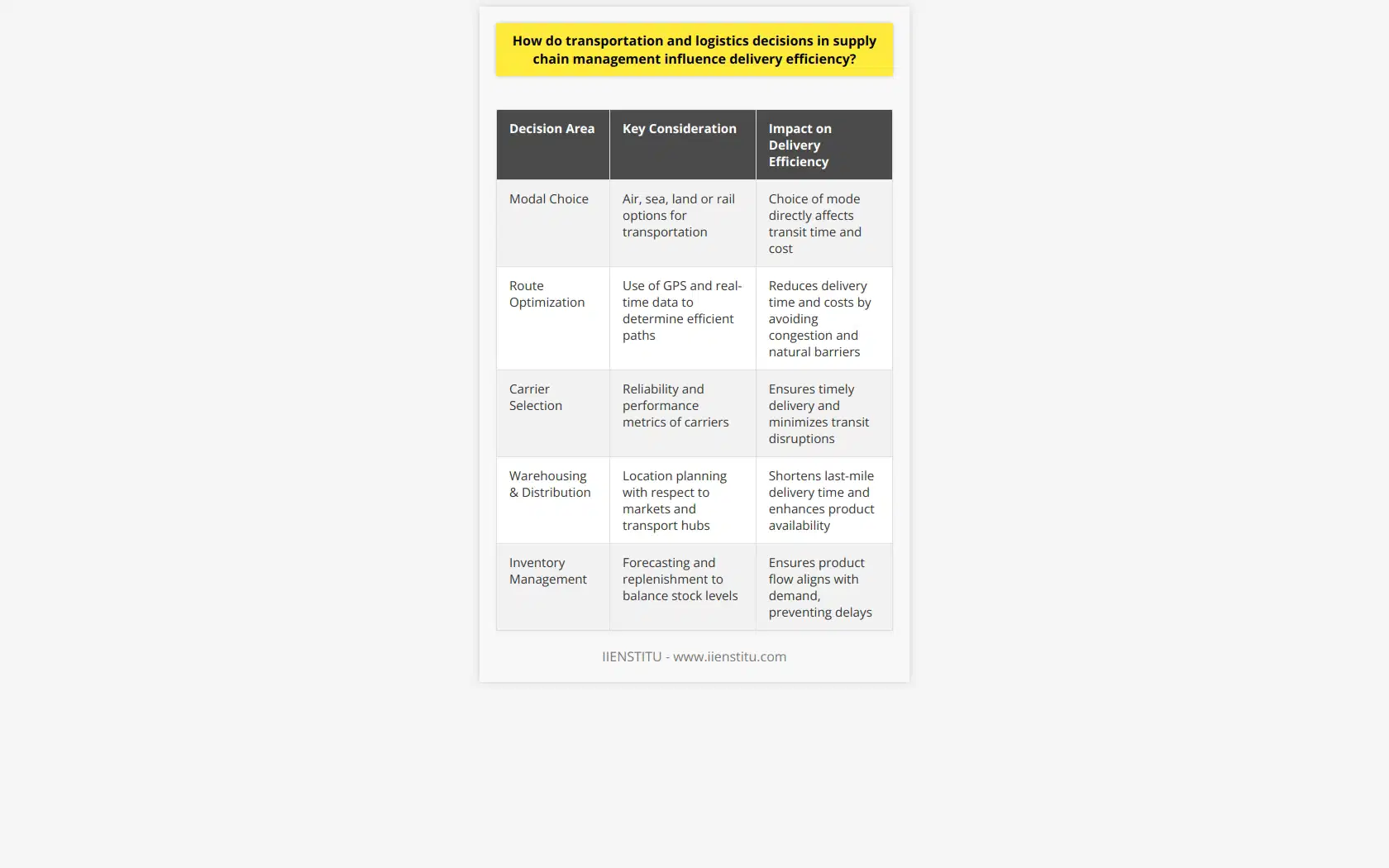
Which performance indicators and metrics should be monitored for successful planning and delivery in supply chain management?
Key Performance Indicators:
Monitoring the right Key Performance Indicators (KPIs) is essential in supply chain management. The right KPIs provide insights on efficiency, effectiveness, and quality of supply chain functions.
Inventory Turnover:
Inventory turnover is one key performance indicator. It gauges how often businesses sell their inventory in a specific period. High inventory turnover usually indicates well-optimized sales and inventory operations.
Order Status and Accuracy:
Order status follows the timeline of orders, from inception to delivery. Accuracy checks if orders are correctly filled. These KPIs can identify early bottlenecks and facilitate timely delivery.
Delivery Time:
One should consider the time taken to deliver goods to customers. Short delivery times enhance customer satisfaction. Timely delivery also helps maintain an optimal inventory level.
Return on Assets:
Return on Assets (ROA) measures the profitability related to company assets. High ROA shows that the company uses its assets effectively to generate profits.
Cycle Time:
Cycle time measures the time taken to complete one cycle of an operation process. Short cycle times indicate efficient processes.
Cost Metrics:
Various cost metrics are crucial. They can include cost of goods sold, transportation cost, and warehousing cost. These metrics help in analyzing overall cost efficiency.
Supplier Performance:
Supplier performance is a crucial indicator of supply reliability. It can include delivery time, order accuracy, and flexibility of the supplier.
In conclusion, a variety of performance indicators and metrics help ensure successful planning and delivery in supply chain management. By consistently monitoring these metrics, businesses can improve efficiency, reduce costs, and enhance customer satisfaction.
